




Neighbors sound the alarm as Tweed New Haven Airport sprawls.
Dear readers,
There are a lot of ways to say goodbye. The poets have tried. Louise Bogan calls it “leave-taking.” Emily Brontë reminds us to “follow out the happiest story.” Perhaps Yvor Winters puts it best: “This is the terminal, the break.” Here we are, at the terminal of our tenure, and there’s not much else to do but wave.
This issue holds a lot of goodbyes. In our cover story, Meg Buzbee explores the pain of saying goodbye to a quiet neighborhood taken over by airport turbulence. Chloe Nguyen explores Connecticut’s new ethnic studies elective and helps us bid farewell to the history curriculum of the past. We have other, smaller goodbyes—odes to the farmland that borders our city campus, farewells to staying quiet in spoken word poetry. A goodbye to home and all of its food, to the expenses of the year, to churches and summer and loved ones.
In our last issue as a managing board, we felt these farewells in everything we did: our last pitch meeting, our last production weekend, our last design proofing all-nighter. Our farewell isn’t unique. When we started our tenure as a board, we read over letters of advice from boards before ours and combed through their challenges. This February, we wrote our own letters. They are also a form of farewell, one that means we will be there for you.
We’re trying to think of this not as a goodbye but as a see you later. We can’t wait to see what our next board does, and the next one, and the next. This journal is as good as our lineage. We’ll be waiting when the plane lands.
With TNJ love always,
Abbey, Jabez, Paola, & Kylie

Thank you to our donors
Neela Banerjee*
Anson M. Beard
James Carney
Andrew Court
Romy Drucker
Jeffrey Foster
David Gerber
David Greenberg *
* Donated twice. Thank you!
Matthew Hamel
Makiko Harunari
James Lowe
Chaitanya Mehra
Ben Mueller
Sarah Nutman
Peter Phleger
Jeffrey Pollock
Editors-in-Chief Jabez Choi
Executive Editor
Adriane Quinlan
Elizabeth Sledge
Gabriel Snyder
Fred Strebeigh
Arya Sundaram
Stuart Weinzimer
Steven Weisman
Suzanne Wittebort
Abbey Kim
Paola Santos
Managing Editor Kylie Volavongsa
Verse Editors
Amal Biskin Cleo Maloney
Senior Editors
Meg Buzbee Ella Goldblum
Nicole Dirks Zachary Groz
Lazo Gitchos
Associate Editors
Naina Agrawal-Hardin Chloe Nguyen
Kinnia Cheuk
John Nguyen
Viola Clune Ingrid Rodríguez Vila
Grace Ellis Netanel Schwartz
Aanika Eragam Etai Smotrich-Barr
Maggie Grether Anouk Yeh
Samantha Liu
Copy Editors
Yvonne Agyapong Iz Klemmer
Connor Arakaki Adam Levine
Lilly Chai Victoria Siebor
Mia Cortés Castro
Podcast Editors
Meg Buzbee Suraj Singareddy
Sawan Garde Adam Winograd
Creative Director Chris de Santis
Design Editors
Tashroom Ahsan Cate Roser
Sarah Feng Jessica Sánchez
Alicia Gan Daniela Woldenberg
Angela Huo Ashley Zheng
Lily Lin
Photography
Web Design
Nithya Guthikonda Makda Assefa
Ellie Park Serena Ulammandakh
Members & Directors: Emily Bazelon • Haley Cohen
Gilliland • Peter Cooper • Andy Court • Jonathan Dach •
Susan Dominus • Kathrin Lassila • Elizabeth Sledge • Fred
Strebeigh • Aliyya Swaby
Advisors: Neela Banerjee • Richard Bradley • Susan
Braudy • Lincoln Caplan • Jay Carney • Joshua Civin •
Richard Conniff • Ruth Conniff • Elisha Cooper • David
Greenberg • Daniel Kurtz-Phelan • Laura Pappano •
Jennifer Pitts • Julia Preston • Lauren Rawbin • David Slifka • John Swansburg • Anya Kamenetz • Steven Weisman • Daniel Yergin
Friends: Nicole Allan • Margaret Bauer • Mark Badger and Laura Heymann • Anson M. Beard • Susan Braudy • Julia
Calagiovanni • Elisha Cooper • Peter Cooper • Andy Court The Elizabethan Club • Leslie Dach • David
Freeman and Judith Gingold • Paul Haigney and Tracey Roberts • Bob Lamm • James Liberman • Alka
Mansukhani • Benjamin Mueller • Sophia Nguyen •
Valerie Nierenberg • Morris Panner • Jennifer Pitts • R.
Anthony Reese • Eric Rutkow • Lainie Rutkow • Laura
Saavedra and David Buckley • Anne-Marie Slaughter •
Elizabeth Sledge • Caroline Smith • Gabriel Snyder •
Elizabeth Steig • John Jeremiah Sullivan • Daphne and David Sydney • Kristian and Margarita Whiteleather •
Blake Townsend Wilson • Daniel Yergin • William Yuen

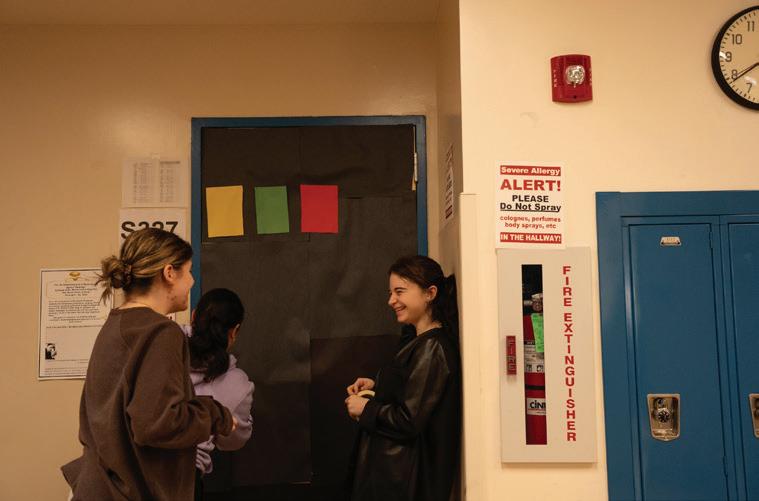
cover story point
Penning Liberation
A writer explores The Word, a New Haven literary arts program for students to gather, write, and perform.
By Kingson Willssnapshots
Decked Out
A tribute to New Haven’s only dedicated skate-shop, Plush, and the public art of street skating.
By Zoya HaqFirst Light
Led by larger-than-life Chef Duff, Sunrise Cafe provides unhoused New Haveners breakfast and community.
By Sophie LambTax Break
Under a complicated national tax filing system, New Haven residents and Yale students come together at the downtown Volunteer Income Tax Assistance site.
By Ai-Li Hollandercrossword: “Skate Park” by Adam Winograd, page 47.
Neighbors sound the alarm as Tweed New Haven Airport sprawls.
By Meg BuzbeeConnecticut became the first state to mandate an ethnic studies elective in high schools. How are New Haven teachers and students navigating the curriculum?
By Chloe Nguyenprofile
Home Truths
A writer seeks out authentic Chinese cuisine guided by Chef Jiang, the man behind his eponymous restaurant.
By Isabelle Qianpersonal essay
Name it to a God
A writer finds holiness in pews, paintings, and poetry.
By Madeline Artpoem
Moses
By Kanyinsola Anifowoshe
aside
That Summer
By Lucy TonThat
endnote
The Old Acre
A writer breaks ground on the myth-like delights of the Yale Farm.
By Lucy Hodgman

A writer explores The Word, a New Haven literary arts program for students to gather, write, and perform.
It’s a full house in the gym of High School in the Community. Tennis shoes squeak as students file into silver rows of bleachers. The air fills with the chatter of three hundred high schoolers left to their own devices.
In front of the crowd is Keiantae, a 16-year-old student rapper about to perform at his school’s Black History Month pep rally.
“I try not to really look at people because when I do I get nervous,” he told me after the show.
But this time, Keiantae can’t resist. As he gazes up from the shiny linoleum flooring, he is met with hundreds of eyes.
Giving a nod to the sound technician, Keiantae takes a deep breath and grips the mic.
Keiantae isn’t just any rapper, he’s a student poet. He’s been honing his craft in The Word, a literary arts program that has operated for twelve years in New Haven. The Word’s goal is to facilitate a radically inclusive writing and performance environment grounded in poetry, rap, and song. Every week, the group hosts “Writing Liberation Workshops” at the Neighborhood Music School— the group’s home base—and in-class poetry workshops in New Haven Public Schools, where students receive guidance on crafting poetry.
It is these workshops that brought me to Keiantae one winter morning in the “Introduction to Poetry” class of MarcAnthony Solli ’91.
In freezing weather, teens crept into class. Icy shoes scuffled along wooden floorboards as the first bell of the school day rang. One final student walked in late and found a seat in the back, a crumpled brown bag of McDonald’s peeking out from his backpack.
Shortly after, Tarishi “M.I.D.N.I.G.H.T.” Schuler entered, dressed in bright crimson red glasses and a hoodie to match. Tarishi is the current artistic director of The Word and the leader of that day’s poetry workshop.
“
M.I.D.N.I.G.H.T. is a pseudonym,” he told me. “It’s an acronym for a name I gave myself in my late teens. It stands for ‘Messiah Is Dominant Now Inspired God Helps Tarishi.’ I was born in 1976 when Alex Haley came out with Roots and a lot of parents were naming their children African names…I didn’t know until my early thirties, my name Tarishi is Swahili for ‘messenger.’ So I ended up being a poet not knowing that’s what my name meant.”
Tarishi, unfazed by the yawning class of sleepy high schoolers, asked for everyone in the room to stand. Chairs squeaked, heads rose, and shoulders slouched across the classroom as fifteen pairs of groggy eyes turned toward the smiling poet.
“Repeat after me,” Tarishi said before clearing his throat. “MEeeeee, MIiiiiii, MOOooooooooo!”
Giggles and laughs fluttered through the air as the students exchanged amused glances. This wasn’t what they had expected.
“He brings life to his poems,” one of the high school students told me after class. “His personality is contagious!” another said.
The mood shifted. One by one, students shared their own poems, greeted with applause from the rest of the class. Tarishi let the students put on their best “poetry-writing music” on the class computer, which the kids used as an opportunity to suggest their favorite new TikTok songs. Students raised their hands nervously, then quickly lowered them when Tarishi jokingly cold-called them to present. If students were too nervous (which they often were), Tarisihi recited his own poems first.
Keiantae sat quietly in the back of the classroom. His hoodie hid two clandestine white AirPods looping the drill beat to his newest poem titled “I Have a Dream” for the upcoming pep rally.
“M.I.D.N.I.G.H.T.’s a cool dude, and he’s so into it. I can’t explain it,” Keiantae told me. “It’s like he brings a different type of energy, and I mess with it.”
Keiantae is part of a new initiative by The Word. He is one of four New Haven Public School teens selected for a program that trains and hires students to become Teaching Artists like Tarishi. The fourteen-week program, which pays students $25 an hour during training, offers hands-on experiences led by mentors. Participants learn how to create course curriculums, lead workshops, and gel with other students in the program. These skills prepare them to eventually serve as independent teaching artists in New Haven.
When I asked him about his classroom’s partnership with The Word, High School in the Community teacher MarcAnthony could not understate its importance.
“It is nothing short of curriculum changing…allowing the curriculum to become a living, tangible, real thing for students where they see someone performing at the highest level of their art,” he says. “And that it is accessible. Right in front of them. Right down the street on Audubon Street.”
Keiantae sees The Word as a space to engage with his art and process hardship.
“New Haven is basically a place you want to get out of,” Keiantae said. “In order for me to make New Haven better, something’s gotta give, something’s gotta change.”
Keiantae first started rapping at the age of 12 after the loss of his father to gun violence.
“I rap about the minor setbacks to a major comeback,” Keiantae said. This adage seems to also be the theme of The Word.
On the first day we met, Tarishi and I sat across from each other in the Neighborhood Music School, about a mile away from High School in the Community. Students meet here weekly to practice for poetry slams and participate in Writing Liberation Workshops.
The day I visited was different than usual. The snack bowl of Goldfish, pretzels, and other goodies was still full. In the room, no one was there but me, Tarishi, and one student poet, Maximilian, who was also experiencing The Word for the first time.
Low turnout has plagued The Word since the start of the pandemic. “A lot of people have been struggling with afterschool programs,” Tarishi said, sliding me a pack of gummies. COVID-19 has imposed hardships on previous attendees of The Word: students lack the time to make art

as they scramble to find jobs to support families—not to mention the anxiety that comes with moving out of social isolation and trying to resume “normal” life with face-to-face interactions.
“But I feel like we are making a lot of progress and strides in the in-school workshops,” he said, referencing the in-class poetry workshops that The Word currently leads in eight public middle and high schools in New Haven.
Back in the gym of High School in the Community, students rise from their seats. Bodies sway and phones flash to the beat. Keiantae looks out to a sea of sparkling lights. As he raps the lyrics he perfected in The Word’s in-class workshop, he announces: “Alright, now I know that y’all mess with it. Let me really give y’all a show.” ∎
Kingson Wills is a sophomore in Silliman College.

In 1887, Moses dies, leaving Sarah alone with two-year-old A’lelia.
I have lifted the still slick tongue of the man. I have placed the coin—cool and heavy—beneath. I have let the mouth swing shut. Relinquished the blue-bruised body.
If there is such a thing as love, I have trembled in its shadow—thick velvet cape trailing, catching in the splintered floor. I have wondered what type of woman this shroud will become.
I have felt a small creature watching me with cavernous eyes. In the night, I have shown my mother-teeth.
—Kanyinsola Anifowoshe
If you turn left from Chapel Street onto Orange Street and walk about a block, chances are you’ll see a group of teenagers performing kickflips and ollies on the pavement. They’ll be outside a storefront with a giant wall of glass. That’s Plush: New Haven’s only dedicated skate shop, decorated with colorful skateboard decks and populated with the trendiest gear on the market.
Sir-Michael Burrow is the employee behind Plush’s white, rounded counter. As soon as I walk in, he shoots me a big smile and waves me over. “Feel free to ask any questions about anything in shop, and I’ll pull it out for you,” he says. He’s sporting a simple white T-shirt and blue jeans, nothing flashy. His outfit blends in with the plain white wall behind him. White accents—they’re everywhere. They contrast sharply with the colorful racks of clothes that hang a few feet from him, displaying popular brands such as Carhartt, Dickies, and Converse.
Burrow is from Waterbury, Connecticut, and has been skating in New Haven since he was 17. Now, at 25, he has a glint in his eyes when he talks about skating. He’s flanked by containers overflowing with skate periodicals and poster books.
Burrow’s favorite word is “sidebar.” As we begin to talk about Plush and its connection to New Haven skating, he throws it into our conversation to add more context to the growth of Connecticut’s skating culture. “Just a sidebar,” he says. “Another sidebar.”
Sidebar: a skate video filmed in Connecticut in the nineteen-nineties called Mama’s Boys brought more skaters to the city and
revitalized New Haven’s scene. Sidebar: when Plush opened, Vans came and shot a piece that put New Haven on the map again. Sidebar: for the past few decades, a vibrant skate film culture has been brewing in the city.
Before Plush opened in 2022, the last skateboarding shop in the city closed in 2015. The closure left New Haven skaters with a long commute to find gear and community.
Alexis Sablone, an Olympic skateboarder, and Trevor Thompson,
also a professional skater, both grew up around New Haven and recognized the inaccessibility of centralized hubs for skating culture in their home state and city. They decided to open Plush, harnessing the power of the local skateboarding community, and the expertise of Connecticut-area skaters like Burrow, to bring the shop to life.
Burrow tells me that their industry connections as professional skaters made the opening process seamless.

“Anyone can open a skate shop, but, like, you need to know what the hell’s actually going on in the trend scene and what companies are cool like the back of your hand,” Burrow said. “As pros, Alexis and Trevor are friends with people who are pros. It’s about being plugged in.”
Rifling through the clothing racks of the store—organized by color to create a rainbow of choices—you’ll find high-end skate brands ranging from the more commercial Vans to the Colorado-based Polar Skate Co. Behind the hanging clothes is a mural of skate decks and boards; to the left of them, you’ll find a wall displaying the most trendy sneakers on the market. The highly-curated selection of options in Plush and the aesthetic of their presentation make it feel like not just a skate shop, but an art gallery.
Plush’s role in New Haven isn’t really retail, though. It’s to create a space where New Haven skaters can come together and build camaraderie.
Plush holds monthly events, like skate video screenings and
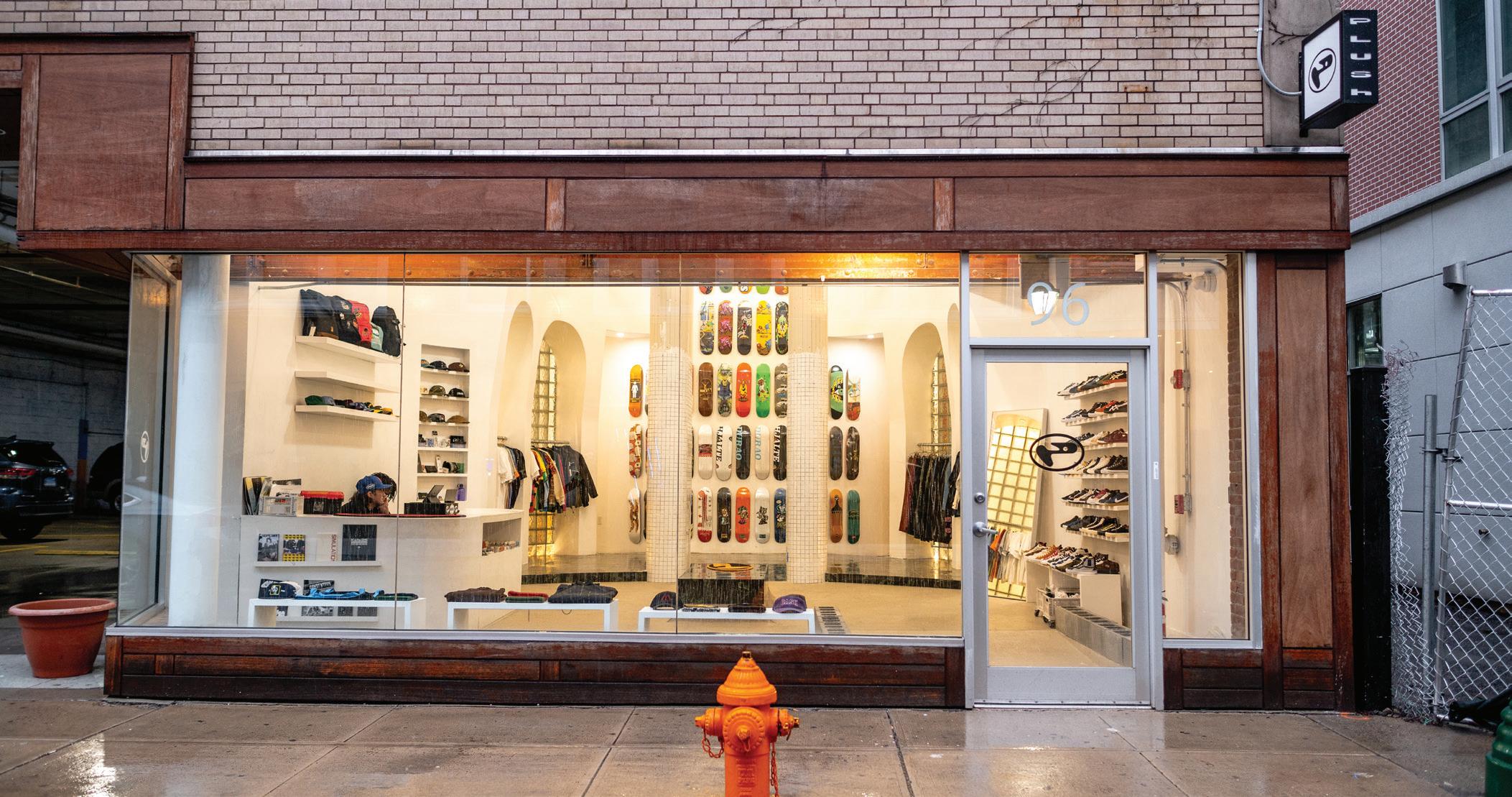
pop-up vintage markets. “It’s a meet up place,” Burrow says. “You have everyone knowing that there’s this one place where they can come together and, you know, skate together whenever.”
Community hubs like Plush naturally function as sites for structural change, too. As a centralized location for skaters, Plush has been instrumental in advocating for more skating spaces in New Haven. The majority of this advocacy can be tied back to Ben Berkowitz, co-owner of Plush.
Since lending a hand to Sablone and Thompson in the opening of Plush, Berkowitz, who is also a local skater, has used the scale of Plush’s wide-reaching community as proof to the city of the need for more skating locations. He’s been successful. Berkowitz worked with New Haven and the Parking Authority Board to transform Temple Street Parking Garage, a formerly unofficial skating hub, into an official indoor skatepark. With his encouragement, city leaders opened Scantlebury Park, a skatepark on Ashmun Street, and a new skating bowl on George Street in 2021.
However, the preservation of street skating, an essential part of skateboarding culture, has been harder to reconcile with the city—and with Yale.
While street skating is not technically illegal in New Haven, it is heavily policed, especially on and around
Yale’s campus. Beinecke Plaza, a popular skate spot, is often patrolled by Yale Security personnel, and skaters have faced backlash—including removal— for trying to skate it and other parts of campus.
“Street skateboarding… it’s kind of what makes skateboarding skateboarding,” Burrow says. “The spirit of resilience, of getting kicked out and coming back is a big portion of street skateboarding. Builds character.”
When I walked into Plush, Burrow had been laughing with four teenage boys, all decked in mostly-black baggy jeans and T-shirts. As soon as Burrow and I start talking, the boys flee to the street. I can still see them outside of Plush’s giant window, skating in circles around the block. One of the boys comes up and taps on the window, making a face at Burrow. He laughs.
“I’ve known these kids for a while because I’ve been skating out here for a few years,” Burrow says. “That’s another thing—skating, shops like these, it gives the kids a place to go instead of a bar or some other time-wasting thing. Skating is…it’s freedom. We’re giving them that here.”
I grew up skateboarding. Walking into Plush, I was instantly comforted by the familiarity of the shop’s environment, its palpably laid-back energy. Hip-hop music played softly over the loudspeakers
as the teenagers around the counter laughed with Burrow. I could have met them in a skatepark back home—they were wearing the same outfits that were so recognizable to me, and had the same quippy way of speaking that felt like a constant challenge. Skating not only liberates; it also connects.
Another tap at the window. It’s been a few minutes since the last. Same kid— same face, small and covered by a mop of light-brown hair. Burrow’s eyes light up. It’s clear that these kids aren’t just shop regulars. They’ve become his friends. Burrow strolls to the door and yells out into the chilly February evening. “Mead! Get in here.”
The kid—no older than 17—glides up to the door and steps in. He’s holding a mini, skateboard-shaped fidget toy. He comes up to me at the counter and gives me a nod. The fidget skateboard flips in his fingers.
Mead taps his foot on the ground. “Are you a student?”
When I nod my head yes, he looks at Burrow and takes a deep breath.
Mead has been skating for six years. “Not that long,” he assures me. His terrain is the street, not the parks. Echoing Burrow’s reflection on the power of street skating, he tells me that street skating preserves skating culture.
“A lot of people that don’t skate assume it’s all about the parks, but
skating started on the street, it’s meant for the street,” he tells me. “Street skating is something you can learn from. You need dedication for it. It’s escapism. I use it to cope.”
For the first time in our conversation, he makes direct eye contact with me. “You go to Yale?”
I nod.
Yale’s Schwarzman Center has funneled thousands of dollars into local skatepark construction, including Scantlebury Park’s and the skate bowl on George Street. While the main publicized reason for this funding has been to support the cultural benefits of skateboarding, Mead thinks that the popularity of Beinecke Plaza as a skate spot acts as a secondary motivation.
“I’ve been wanting to tell someone this, so Yale should hear it. They have power,” he says. He flips his fidget skateboard on the counter. “Just because the city and Yale keep building these skateparks and stuff doesn’t mean that they change anything for us street skaters. Pouring money into that isn’t going to change the fact that we’re going to skate Beinecke.”
He articulates his final point with a passion that differs from his earlier drawl: “And if they really want us to stay off their property, don’t build the skateparks outside. Like, centralize it in the city. It’s a trek to get to the parks.”
He’s not wrong. The closest park to Plush is Scantlebury Park, located behind Pauli Murray College off of Ashmun Street. It’s a twenty-five-minute walk from Plush’s centralized, downtown location.
The next day, I make the journey up to Scantlebury, located off the Canal Trail. My jacket barely keeps me warm against the frigid wind. It beats at my face as I navigate the icy sidewalk. The playground next to the skatepark is, unsurprisingly, empty. As I trek up the short hill that leads to the base of the park, though, I can hear the click of wheels against asphalt. The only person within eyesight is a single skateboarder practicing tricks on the slopes.
His name is Michael Skirkanich. He’s middle-aged, definitely older than the kids I saw at Plush. Unlike them, he’s wearing a helmet. “Don’t want to crack my head open,” he says. When I sit down on the concrete next to the skatepark, we begin to talk about Scantlebury.
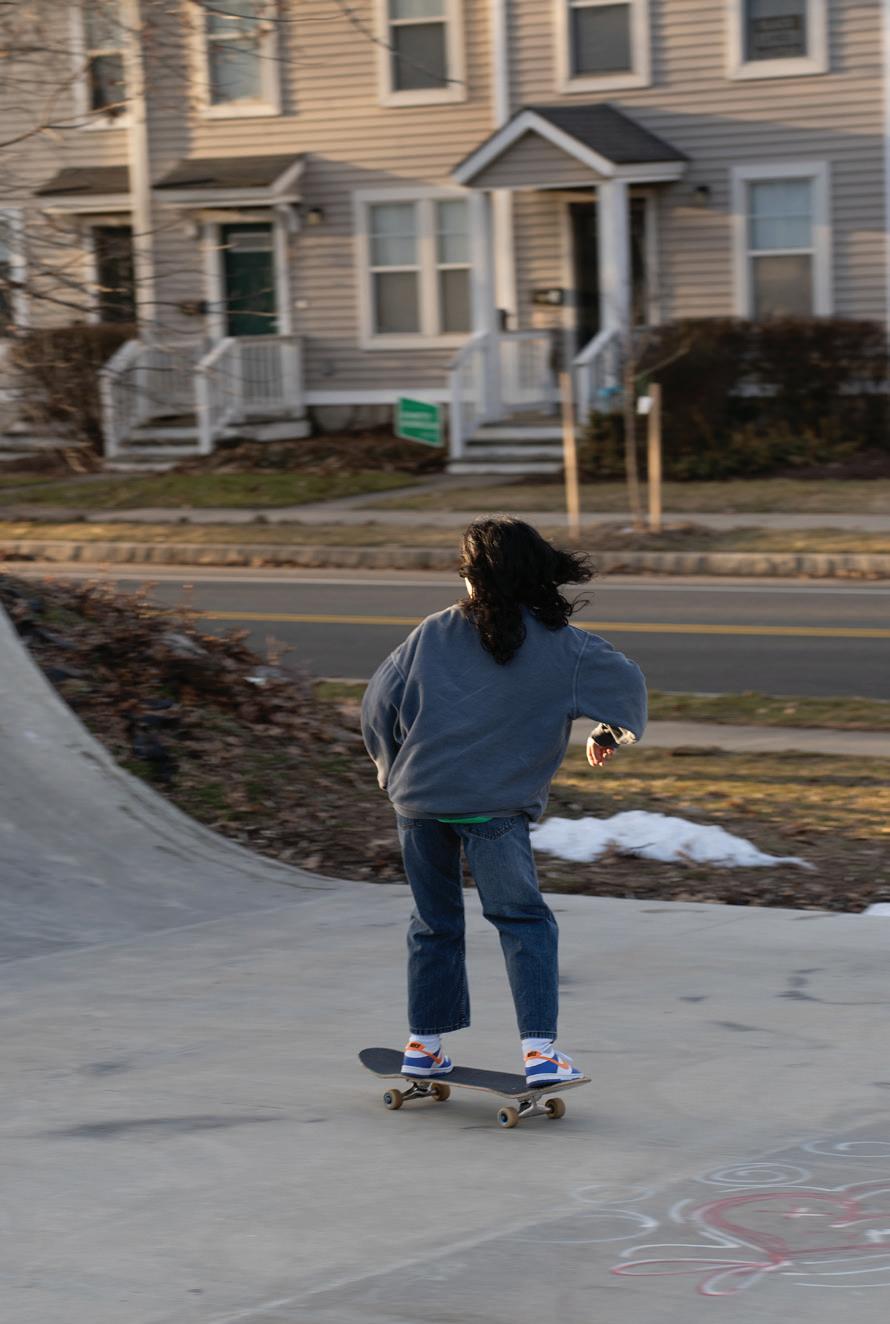
the musicality of the sport, the rhythm of the wheels. I think that, in a strange way, my yearning for that feeling was what made me so interested in the presence of skateboarding on every street in New Haven—one of the first things I noticed about the city was how much skating was embedded into its culture. At street corners and in parks, on campus and off, there are skaters. The sound of wheels on asphalt is an essential part of the urban melody of my new home.
I stopped skateboarding when I was 15 because of a shoelace-in-wheel trip that left me in an arm cast for a month. Sitting criss-cross on the side of the curving, concrete slopes, I tell Skirkanich this. I tell him about the weird fear I have of stepping on a board now, about how it reminds me of the crack I heard— and the instant shoot of pain I felt—four years ago when I last did it. He scoffs.
“You’re telling me you broke your wrist four years ago and haven’t gotten back on a board? I broke my ankle. I’m here,” he says. I’m reminded of Burrow’s point: that skating is all about resilience. You just have to keep going for it. Skirkanich echoes him. “You have to keep trying, keep going for it.”
“Come stand on my board and you’ll see,” he says. “You gotta try.”
“I like being out here alone,” he tells me. “When I’m here, I don’t care about, think about anything else. It’s just skateboarding. Without the squirts—the teens—I can focus.”
As we’re talking, he pauses every so often to focus on a particular trick or flip. “I come out here seven, eight hours a day,” he explains. “I see every day as a good day or a training day.”
Unlike Mead, the skatepark is an essential space for Michael. It provides a structured space for him to focus on the “artistic” side of his skating craft.
After all, to him, skateboarding is, in one word, self-fulfillment. “Not many people can do this, and that fulfills me. Landing a trick, the sound, it’s like music, it fills me up.”
Music. He’s right. I’m reminded again of my own skating roots. I used to love
He waves me over, kicks his board towards me. “It’s all about baby steps.”
I balance myself on his board. He holds his arm out. “Hey, it’s nice. Mercedes of skateboards. Be careful,” he makes sure to let me know. For the first time in a long while, I feel the liberation of skating. How it is freedom, like Burrow told me, how it is self-fulfillment, like Michael tells me, and I get it. It clicks.
Back at Plush, Burrow left me with some words that pretty much sum it up. “New Haven, skating, music, culture, film, they all go hand in hand,” Burrow told me. “Skating is art. It needs to be treated like art. It needs to be respected like art.”
Art on the street—art in the park. Both go hand in hand. Skateboarding, as art, is an inherently public sport. It deserves space both in structured environments and in the city at large.
Stand on a board like I did, and maybe you’ll get it too. ∎
Led by larger-than-life Chef Duff, Sunrise Cafe provides unhoused New Haveners breakfast and community.
By Sophie Lamb
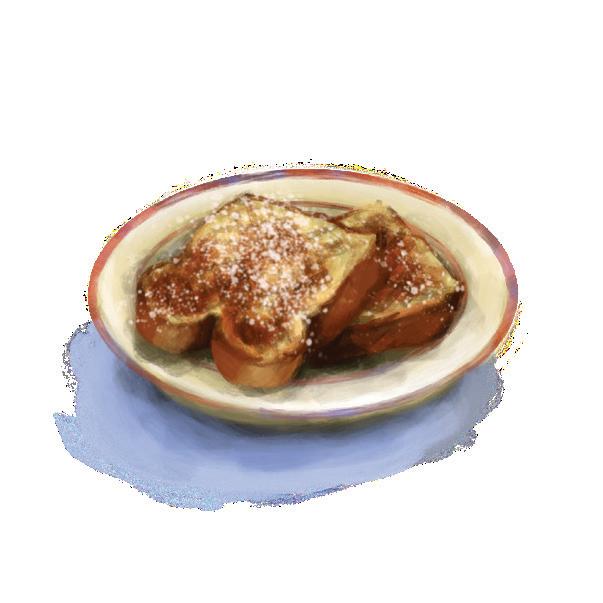
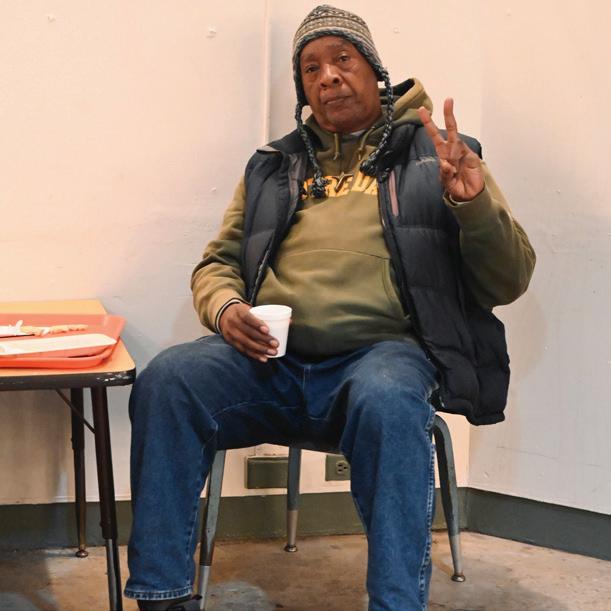

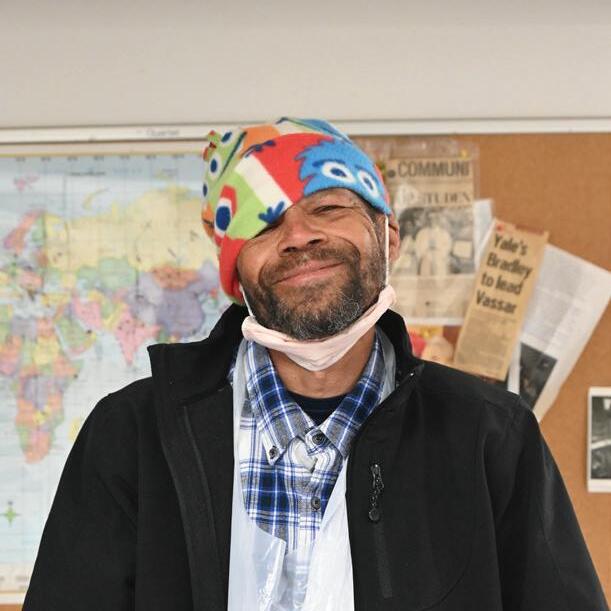




Paul McDuffy has been feeding people since he was 12. “We were raised poor,” he tells me after his Friday shift at Sunrise Cafe. “And because of being poor, my mom taught us how to stretch $1 in the community.” McDuffy has lived in New Haven his entire life. He reminisces about the butcher at Ferraro’s Market who taught him to use his family’s food stamps to buy food in bulk, and the Westville neighborhood barbecues where his mom laid out burgers dripping in mayo and relish.
McDuffy—or Chef Duff, as he’s affectionately called by guests and coworkers at Sunrise Cafe—likes to use “we” interchangeably with “I” when he talks about food. Towering over staff in a threadbare apron and wrecked purple Jordans—a gift from his best friend and “corner brother”—Duff has a gentle gravity. He grew up in the nineteen-eighties, as New Haven faced economic collapse. The city was razing once-vibrant communities to construct the Oak Street Connector interstate, and the fiery factories that guarded the city’s harbor were transforming into vacant redbrick shells. From 1970 to 1980, the city went from being the thirty-eighth most impoverished in the nation to the seventh. By the time Duff was in ninth grade, a quarter of New Haven youth were living below the poverty line.
bus stop. When one approached him, his immediate reflex was to hand her the contents of his wallet. “She politely said ‘No, sir, I really don’t want your money. I really am hungry.’” Instead of taking the bus home, Duff took the bus to Stop & Shop, bought $12 worth of canned bologna and Wonder Bread, and returned to the Green.
He kept coming back. Five days a week, Duff finished his guard shift and started cooking. His meals morphed from bologna sandwiches to boiling pots of meatball chili; he went from feeding ten people to hundreds. Friends and strangers alike helped him buy groceries and serve. “It was cool,” Duff says,
I first volunteered at Sunrise in late October. On the dark walk along Chapel Street, I anticipated a standard soup kitchen—bags of pre-packed food, limited seating, and a line of people twisting out onto the sidewalk. Instead, when I stepped through its glass doors, I was greeted with rows of white tablecloths stretched taut over wooden tables, slouching with fat vases of flowers and steaming cups of coffee. Guests sat and laughed, or danced to music spilling from a piano in the corner. A couple of volunteers ran from an industrial kitchen out into the dining room, balancing trays piled high with fish tacos, french toast, and orange juice.
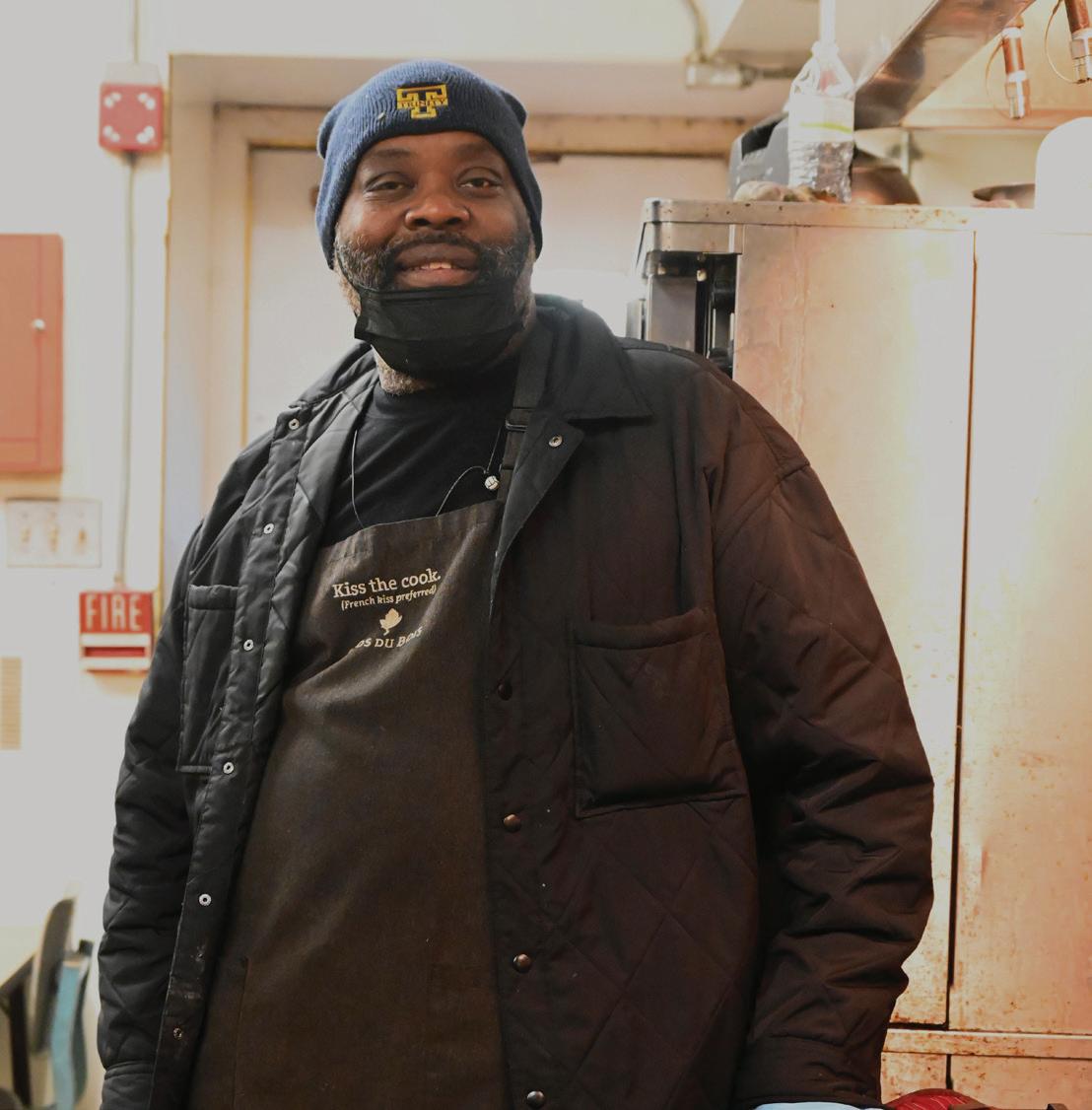
Duff’s classrooms were marked by conflict. His mom used to warn him: “Kids act out and bully other kids because they’re hungry.” She would pack an extra chicken sandwich in his bag each day to feed friends who didn’t have food at home. Watching them smile after a good meal invigorated pre-teen Duff: “We can show people love through food [so] I made a promise to feed as many people as possible.”
In 2015, Duff began working overnight shifts as a security guard. He recalls walking past a group of ten unhoused girls huddled against the morning chill on the New Haven Green, on his way to the Chapel Street
“It was like the community was backing me.” In November 2020, word of Duff’s cooking and tenacity reached Sunrise Cafe’s doorstep. At the time, Sunrise was struggling with a dramatic drop in guests and fluctuations in kitchen staff.
Now it’s bustling. Open weekdays at 6:30 a.m., Sunrise serves free breakfast to some three hundred unhoused guests out of the basement of St. Paul and St. James’s church. Chef Duff uses donated ingredients to cook a perpetually rotating menu of fried fish tacos, sausage and grits, lasagna, French toast, and fried chicken. When I ask why lasagna for breakfast, Duff laughs. “I want to treat them. I want them to eat what they usually don’t get to eat.”
Sunrise’s full menu and restaurant-style ordering system is the work of Ellen Gabrielle, who founded Sunrise in 2015. She envisioned a more humane soup kitchen— complete with a menu where guests can order and have food brought to them in a restaurant-style service model.
Sally, a retired nurse and social worker, has been volunteering for Sunrise since the beginning. She watched Ellen build the Cafe. “Yes, these places are very important for feeding… people. [But] the goal from the beginning was to make [Sunrise] a dignified place to eat.” Throughout our conversation, she keeps returning to the word “dignified.” If guests need an extra pair of gloves, clean socks, or someone to talk to, they ask for Sally. Wrapped in a mask, glasses, gloves, and a plastic apron, she slips between the kitchen, food pantry, and clothing closet with her keychain in hand.
Most mornings, Robert eats behind Sunrise’s piano. “I play it any chance I can. So I don’t forget,” he tells me with a smile, adjusting his black beanie as we talk. “Not having a place to be is a lot of pain to bear, so I use piano to get away from the suffering.” He pauses, placing his battered copy of R&B For Dummies on the music rack, and erupts: long fingers delicately pulling across the length of the glittering Yamaha, head swaying,
eyes closed. Finding serendipitous joy like this is Robert’s driving conviction. “It’s good you can come to a place early in the morning to eat. And I get to play the piano here. That brings me happiness.”
Fostering a comforting space hasn’t always been easy. When Duff first arrived, “it was hard for us [to] even serve a meal without a fight breaking out.” He’s “quit in his head” a thousand times over. The weight of these challenges is built into the fabric of Sunrise: the heavily bolted pantry, plastic knives, and worn-through floors.
“Some days it’s intense. People have their moments,” says Casey, a mom of five who just moved to New Haven from Alaska. “Moments” are what Casey calls fights. Her oldest son, Eprum, a tall, curly-haired teen, sits next to me. “[Eprum] has moments all the time… because that’s what they are. They’re over soon.”
He reminisces about the butcher at Ferraro’s Market who taught him to use his family’s food stamps to buy food in bulk, and the Westville neighborhood barbecues where his mom laid out burgers dripping in mayo and relish.
I sit down with Casey during a lull in my morning service. She’s soft-spoken, swathed in two jackets to keep warm from the January chill. As we talk, she turns away from me to lock eyes with Eprum, or leans over to brush the hair from her one-year-old’s forehead. Eprum is autistic, and Casey is solely responsible for his education. Between teaching and caring for her toddler, Casey hasn’t had time to find a job. The family is currently living in the Continuum Shelter on Foxon Boulevard. At the end of February, their ninety-day stay period will run out. “We don’t know what we’re going to do,” she says, her fingers wrapped tightly around Eprum’s hand. They’re hoping to receive a Section 8 voucher—a federally
mandated program that subsidizes the cost of rent for low-income people—but, according to the Connecticut Department of Housing, it can take up to “a few months’’ for their application to be processed.
Robert is also trying to get Section 8 benefits. “To get a voucher you need papers. And it’s impossible to keep track of papers when you carry your life on your back. It’s not like you can lock your Social Security Card in a bush.” He laughs and fiddles with a few keys. “Right?”
The day we talk, Robert is leaving Sunrise early to attend a series of job interviews. He’s nervous about employment—he’s still reeling from a string of exploitative employers and worries the time spent on a job will be time taken away from finding housing. Earlier this year, he was hired to put up a wall for a church—a three-week stint of nailing, plastering, painting, and sweating in a church basement. “I went to the lady for my paycheck,” he says, “and she told me, ‘I’m not paying you.’ They know that if you don’t have a permit, a license, not insured, you don’t have a leg to stand on.”
Between fleeting conversations with guests and volunteers, I met a construction worker reeling from eviction, a musician from New Orleans who found a place to live, and a Yale Law School graduate grieving a brutal divorce. Despite varying tracks to homelessness, guests share parallel experiences in their fight to escape it. They describe their first nights without a home spent on friends’ couches and in cars; when their friends’ patience ran out, they turned to temporary shelters. These shelters house people anywhere from three to ninety days. But as homelessness rates continue to increase in Connecticut, shelter housing is stretched thin, leaving long waiting lists, and overcrowded accommodation. In hopes of a more reliable option, many apply for Section 8. But, as in Casey and Robert’s case, this process can take months. As shelter slips in and out of place, many end up on the streets. Most days, Robert walks until he finds somewhere safe enough to sleep: “There’s really no place where you can sit and be. You’re just wandering.”
In Sunrise’s cluttered kitchen, I meet Nelson, a dimpled, grinning 30-something who came to New Haven from Puerto Rico when he was 7. The move made him grow up fast; he supported himself and his sisters


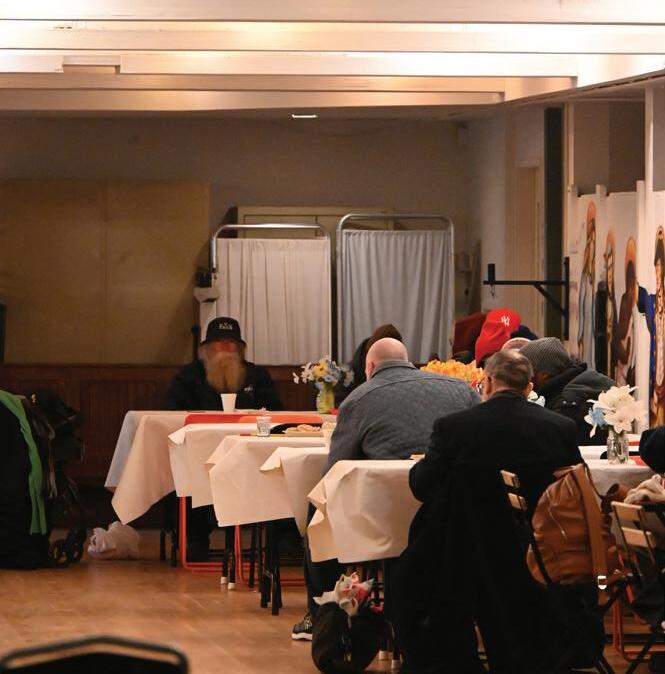
through high school before meeting his girlfriend of ten years. Nelson first became homeless after his girlfriend suffered a stroke, and he couldn’t spread his income thin enough to cover the costs of rent and healthcare. He thought he would never escape. “I used to sleep in hallways,” he tells me. “When I couldn’t find food, I just drank water.” For twelve years, he bounced between housing arrangements and living on the streets until landing in prison four years ago. He’s currently living in a halfway house
“Get angry. We're all in this fight together,”
Chef Duff tells all of Sunrise’s guests. He wants them to walk through these doors and leave better.
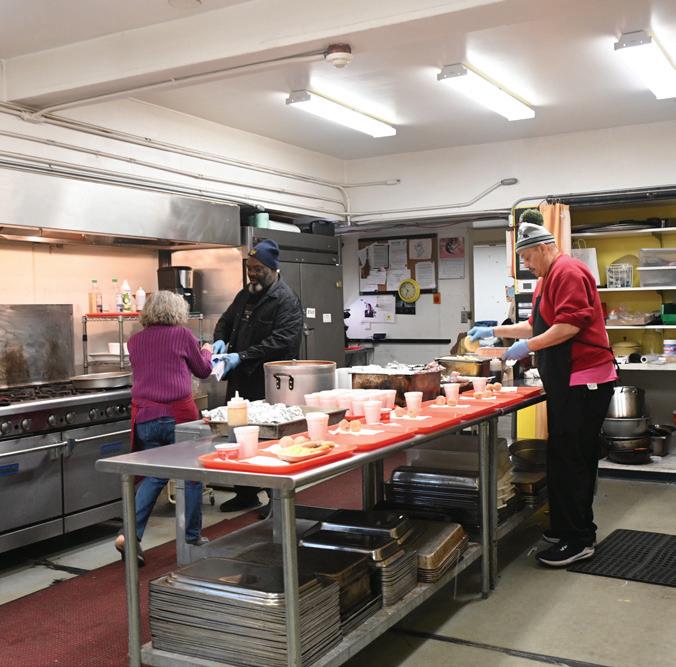

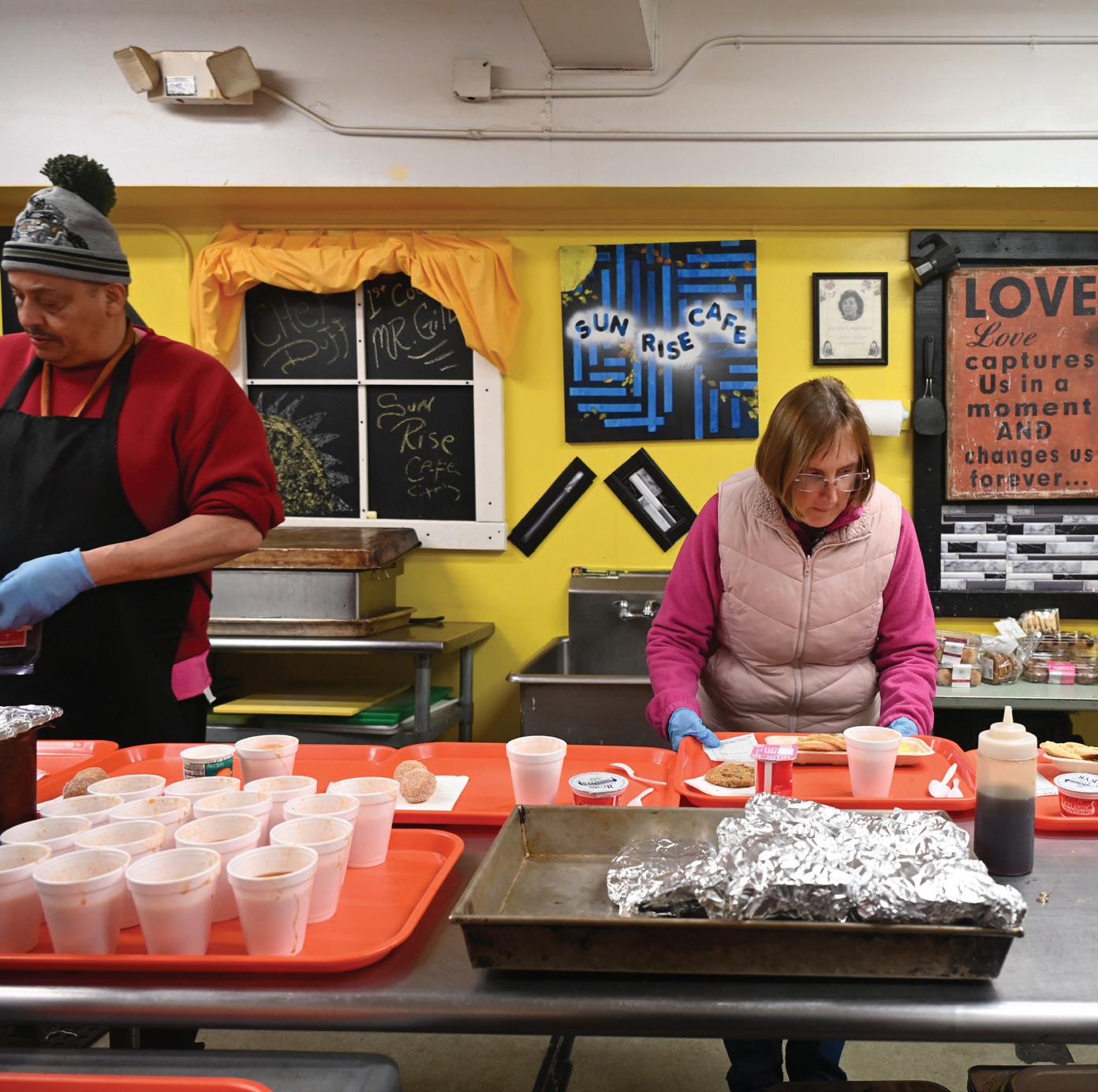
I was starving on the streets. Now I can be that help for someone else.” For many of the volunteers, working at Sunrise is a way to reconcile their experiences with homelessness.
However, for many of the guests, eating at Sunrise can hold up a mirror to the battles they are facing. Robert stops me at the door. “I need you to know I don’t ever feel good having to come here another day," he says.“You go in Sunrise and you look around and you see what you’re going through ten by ten by a hundred times.”
Duff believes there can be power in that. “Get angry. We’re all in this fight together,” he tells all of Sunrise’s guests. He wants them to walk through these doors and “leave better”—whether that is wiping down a tablecloth or getting sober. Duff speaks a lot about the successes and failures he watches pass through Sunrise’s walls: “Everybody who [gets] a job comes to me and says ‘Chef, I have a job.’” They tell him if they found new housing or bought their girlfriend a coat. They also tell him if they relapse or get kicked out of a shelter.
triumphantly chants, “Baby’s here, baby’s here!” Arms laden with goodies—and a steaming stack of chocolate pancakes— he hugs Casey, Eprum, and Casey’s oneyear-old. The chaos of Sunrise swells around them: piano filling the air, steam rising from cups of hot coffee, laughter booming from the kitchen. Casey left her support system when she left Alaska. “But Chef takes care of us,” she smiles.
“Evil works twenty-four hours a day. It never takes a break. It never rests. It never stops.” Duff’s voice cracks as he tells me this. You can feel this evil pressing in on all sides of Sunrise, a midnight swarm of evictions and addictions, of bad employers and bottomless legal battles. “I gotta go ahead and make sure we love each other.” ∎
Sophie Lamb is a first-year in Jonathan Edwards College. while he works on getting back on his feet. One of the ways he’s healing is by waking up at 5 a.m. every morning to volunteer at Sunrise. Nelson brims with enthusiasm, carrying trays of food three at a time, high-fiving and hugging me as we pass each other. “I wished someone would help me when
Running to the back pantry to collect a bag of mango yogurt, stuffed unicorns, and applesauce, Duff

Check out the second episode of the TNJ Podcast! In this episode, Suraj Singareddy interviews organizers with Yalies4Palestine and Jews4Ceasefire, Meg Buzbee digs deeper into her investigation on Tweed New Haven Airport, and Sophie Lamb brings us into Sunrise Cafe. Listen to these stories, and more, on The New Journal website!


 By Meg Buzbee
By Meg Buzbee

Diana Gilman-Ford doesn’t like to fly. She hasn’t been on a plane since the late nineteen-nineties, and even then, she didn’t make it off the ground. While the plane was still on the tarmac, she suffered a panic attack and had to disembark. Still, for most of her life, GilmanFord looked up at planes in the sky with awe. What a marvel, she used to think. Men in the sky.
Then, in August 2022, Tweed New Haven Airport, located just 50 yards down the street from Gilman-Ford’s house, entered into a forty-three-year contract with the airport management company Avports LLC . The deal paved the way for a one-hundred-million-dollar investment in the expansion of the airport. A year earlier, in May 2021, the Airport Authority had announced a new partnership with Avelo Airlines, an ultra-low-cost carrier that began offering flights out of New Haven in November 2021.
Now, over twenty Boeing 737 jets take off and land each day on the Tweed runway, situated three miles from downtown New Haven. Sometimes the jets move as late as 10:30 p.m. Gilman-Ford calls her house, which she has lived in for twelve years, a newfound “nightmare.” She keeps her windows closed to block the smell of jet fuel. She stopped hanging the clothesline and pruning the garden last year. And then there’s the noise. “I don’t even have words for the noise,” Gilman-Ford said. “There are times it’s so bad you cannot even function.”
“I have great empathy for people who live near the airport,” said Matthew Hoey, the First Selectman of Guilford and Chair of the Tweed

Airport Authority Board. Still, he has supported the airport expansion from the beginning. He worked with Avports and Avelo in the initial stages to secure their investments. From his perspective, the expansion of Tweed is for the common good. “The success of the airport has spillover for the region, and for the immediate vicinity,” Hoey said. And besides, “No one who bought a house didn’t know the airport was there.”
Opponents and proponents of the Tweed Airport expansion seem to operate in entirely different registers. Critics of the airport, largely residing within a few miles of Tweed, denounce the noise and air pollution, as well as increased traffic and safety concerns. Gretl Gallicchio, who lives in New Haven near the airport, said that she had to “completely reevaluate what it means to have a future” in her once quiet neighborhood. “It’s depressing,” she said, “to watch the place where we’ve lived be destroyed.”
Residents of these low-lying, shoreline neighborhoods already contend with warming and flooding, local consequences of the global climate crisis. They are skeptical of the value of Tweed’s future LEED -certified, energy-efficient terminal—especially when the aviation industry plays a massive role in carbon emissions. Such environmental concerns would be compounded by jumbo jets, the traffic, and the increased strain on emergency services that will come with the expansion.
Proponents of the airport are quick to recognize these concerns but dismiss them with
utilitarian logic—more people will benefit from Tweed than will be hurt, and thus the expansion will be justified. The benefit takes many forms: economic growth from jobs in aviation and construction, accessible and affordable travel from Avelo’s budget flights, and a potential decrease in energy use after construction of the new, LEED-certified terminal.
The one thing everyone can agree upon is how enormous and successful the expansion of Tweed services has been already, and how impactful future changes will likely continue to be. Since the first Avelo flight took off from New Haven on November 3, 2021, and landed in Orlando about two hours later, Avports has seen an eleven-fold increase in air traffic at Tweed. In 2020, there were thirty-eight thousand enplanements at Tweed. In 2023, there were 465,538. According to Tom Rafter, Executive Director of the Tweed New Haven Airport Authority, Tweed is the second fastest-growing airport in the United States. This may only be the start. Under Avports’ master plan for its lease from the Airport Authority, effective until 2065, the company will invest one hundred million dollars into Tweed and oversee the construction of a new terminal and extension of the runway.
To Hoey, New Haven Mayor Justin Elicker, and most other politicians with a stake in the fight, the equation is simple. Tweed brings jobs and revenue to the region. Private investment from Goldman Sachs-owned Avports pays for the venture. Government departments oversee permits and regulations to ensure that construction is up to federal standards. The world carries on, the same as it always has, now with six additional flights from New Haven to Florida every day. But for residents like Gilman-Ford, it’s a world changed. The noise that disrupts her sleep, the vegetable garden and clotheslines she feels she’s lost access to, and the black soot she says covers the outside
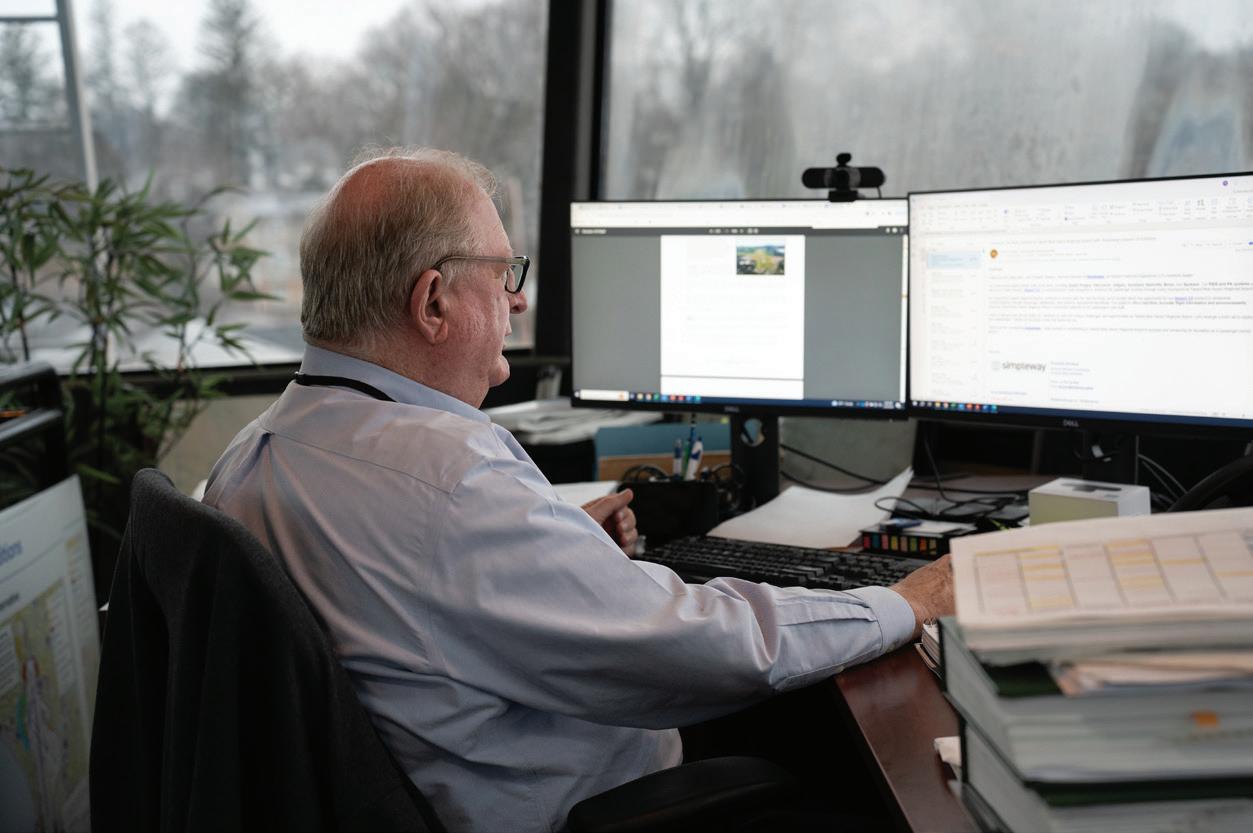
of her house are enough signs of the impact. “I don’t care what that study says,” she said, speaking about federal environmental impact reports. “Because we know, we’re living here.”
For all its rapid growth, Tweed is tiny, sitting low down in a large bowl just twelve feet above sea level. To get there, drivers exit I-95, the main throughway to town, and roll down a two-lane road with yellow lines down the middle and parking lanes on either side. Only small green signs with a white airplane icon and an arrow indicate that Tweed is nearby. Single-family homes spaced about 15 feet apart with grassy lawns line the block. Speed bumps and yard signs increase in number closer to the airport: “Keep Tweed Small,” they read. On the tarmac, across the street and behind the terminal, there’s usually at least one purple, white, and yellow Avelo 737 jet. Morris Creek flows underneath the air traffic control tower, underneath the terminal, and down the tarmac on the other side.
Tweed Airport is not a new addition to this tree-lined New Haven neighborhood. Opened in 1931 as the New Haven Municipal Airport, it took the name Tweed in 1961 from its first manager, John H. Tweed. Having purchased the land from East Haven in 1931, the City of New Haven fully owns the acres that Tweed sits on and leases it to the Tweed Airport Authority. The complex also crosses into neighboring East Haven, although East Haven does not share any financial ownership. Throughout the twentieth century, flight offerings shifted as different airlines attempted to run routes through New Haven. Due to the short length of the runway and small terminal, planes were small and flight schedules inconsistent. More often than not, passengers chose to fly from New York, Hartford, or Westchester instead.
Before 2021, there were not constant 737s at Tweed as there are today, which seat up to 120 passengers; instead, just narrow-bodied airliners seating about seventy-five people maximum. This was due to a 2015 legal battle, where the Connecticut government prevented the Airport Authority from expanding the length of the runway. The move would have allowed for larger planes and additional carriers to service Tweed. Then, in July 2019, the Second Circuit Court of Appeals reversed that decision.
Rafter, the Executive Director of the Airport Authority, keeps a small orange booklet with the details of the Supreme Court ruling on his desk at his Tweed office. It reminds him of past resistance to the airport and the avenues through which expansion was still able to move forward.
Rafter, like Hoey, who sits on the board, seems unfazed by local opposition to Tweed
expansion. A veteran of the aviation industry, he’s been in similar situations before. “I’ve lived at the end of runways, I’ve lived near airports,” Rafter said. “I understand their concerns.” He says opponents, though vocal, are not the only ones with an opinion about Tweed. The people who use the airport, who fly the Avelo flights, park in the nearby parking lot, and work jobs in the terminal, he argues, are showing their support for the airport and its expansion through their actions. Tweed also has its vocal cheerleaders: numerous residents of New Haven, East Haven, and surrounding towns who post updates on new Avelo routes, videos taking off over the Long Island Sound, and updates on weather delays.
Yale students and affiliates alike also frequently fly through Tweed. Camila Young ’26 has taken over twelve Avelo flights since beginning college between New Haven and her home in Miami. “I really like Tweed,” she said. For Young, the small airport is convenient and she finds the people there friendly. “It seems kind of like the mom-and-pop version of the airport.”
Most days, Rafter has the tower to himself. From up here, he can see the entire expanse of Tweed: the houses on Burr Street which sit right across from the airport gates; the cars loading and unloading in front of the terminal; the brook that runs from the parking lot to the tower; and the planes as they land, taxi, disembark passengers, and take off again. Above it all is the expansive sky, visible for 360 degrees from the wrap-around windows in Rafter’s tower.
From up here, Tweed looks beautiful. The tarmac is lower than the surrounding houses, with orange and red foliage on all sides. To the East Haven side of the airport, where the new terminal will be built, Rafter points out a few commercial buildings and the woods he says separates the airport from residential areas. “The longest highway in the world is a runway,” he says. “There are airports around the entire country and they are part of a larger system.”
Gilman-Ford stands in the parking lot of Robinson Aviation on the east side of the terminal, watching the planes. Next to her, the surface of her car, a 2010 Mercury Sable, is covered in a thin layer of brown grime which she says is from airplane combustion. A yellow “Stop Tweed Expansion” sticker is peeling off at the edges. A plane took off three minutes ago, and it takes that long for the jet fumes to make their way over on the wind.
Both Gilman-Ford and her daughter have asthma. She said her daughter’s asthma attacks

have become more frequent since Avelo arrived. In East Haven, more than 21 percent of children have asthma compared to just 14 percent in New Haven and just 13 percent throughout the rest of Connecticut. East Haven is already home to several oil storage facilities, power plants, and trash collections, not to mention a mile-long stretch of I-95. East Haven is also an Environmental Justice Community, defined by the Connecticut state government as an area with high poverty rates where developers must have a plan to engage local stakeholders before they can seek permits. This is usually done through public meetings or comment periods, where residents can provide feedback on proposed plans. Because Tweed has been zoned as an airport since its inception, and because airports fall largely under federal jurisdiction, the expansion hasn’t legally required all these state-level procedures.
As a result, some residents have taken it upon themselves to assess the environmental and health impacts of Tweed on the already-impacted communities. A local environmental group called 10,000 Hawks partnered with Tufts University researcher Neelakshi Hudda to study air pollution around Tweed. Residents kept air quality monitors in their homes over the course of two weeks. Hudda found that ultrafine air pollution particles increase by 188 percent during plane takeoff and landing, up to half a mile away from the airport.
In December 2023, the Federal Aviation Authority ( FAA ) issued a Finding of No Significant Impact ( FONSI ), which concluded that Tweed’s expansion would have no significant impact on the environment. This finding was the result of the FAA Environmental Assessment ( EA ), a routine procedure that must be completed for expansion plans to move forward.
“When I heard the news of the FONSI I burst into tears and I doubled over on the floor,” Gallicchio said. “I was literally that shocked. The EA was a complete shocking act of greenwashing.”
Save the Sound, a New Haven-based nonprofit, is currently appealing the Environmental Assessment. It cites the numerous state and federal agencies—including the Environmental Protection Agency, the U.S. Department of Health and Human Services, and the Connecticut Department of Energy and Environmental Protection—that, like Gallicchio, have pointed out shortcomings in the document. For example, ultrafine particle pollution was not considered in the FAA’s EA, as these are not federally-regulated pollutants. Neither were the impacts of leaded fuel used by small, private aircrafts. Wetland impacts are also largely left out of the document, which states that there are “no critical habitats within the project site,” a fact that local residents and Save the Sound refute.
According to the National Oceanic and Atmospheric Administration, the aviation industry accounts for 3.5 percent of warming worldwide. If the industry were a country, it would be the sixth-largest emitter in the world as of 2019. Opponents of Tweed see this as a key reason to limit the growth of the airport. “This is an expansion of an impossibly wet, small, foggy airport during an era of climate crisis when every responsible policy maker I know talks about ways we need to reduce our carbon usage and our carbon footprint,” Gallicchio said. She said that when she brought up these concerns to Elicker in a July 2022 meeting with him and Economic Development Administrator Michael Piscitelli, she was quickly dismissed.
“[Piscitelli] said that global warming is a global problem and this is a local issue,”
Gallicchio said. Piscitelli did not recall this conversation and referenced the potential local environmental benefits from moving the terminal—including higher stormwater storage capacity at the airport. Elicker also contested that this is his administration’s position. “[Planes] have jet fuel that is detrimental for the climate,” Elicker said. “But that doesn’t mean we should never fly anywhere. We can’t look at the airport in isolation and there is so much we are doing as a city to reduce our climate impacts.”
The current expansion put forth by Avports includes plans for a six-story parking garage, a 638-foot runway expansion, a 462,500 square-foot airplane parking building, and the new terminal that will come in at around 80,000 square feet. Residents and environmental activists alike fear the potential harm this construction will have on surrounding wetlands, and also the prevalence of flooding. Low-lying and coastal East Haven is already a flood-prone city, with almost a third of homes at severe risk of flooding within the next thirty years. The new terminal will be built on stilts to protect against future water damage. This is still a rare design for airport terminals, but one that might become more popular as flood risks from climate change increase.
Throughout the three-year expansion fight, opponents have complained that everyone seems to be paying attention to other things, anything but Tweed, including those who are tasked to legislate on it. At an April 2023 meeting of the South Central Regional Council of Governments, East Haven Mayor Joseph Carfora accused his colleagues of negligence as they voted to pass a resolution in support of the Tweed expansion and the draft Environmental Assessment.
“First of all, I want to ask everyone on this board,” Carfora said to the assembled council. “Has anybody read this EA ?” It was a hybrid meeting—Elicker called via Zoom from his New Haven office. Carfora held up a copy of the 216-page draft environmental assessment document, spiral bound with a plastic cover. “Has anybody took the time out to read this?”
Hoey and Elicker responded that they had read most of it, but only two other people in the adjoined crowd raised their hand, both onlookers, not members of the council. “I want to ask all of you,” Carfora then said. “How can you vote if you don’t know what’s in this?” The rest of the members looked on, a few holding on to their hands, as Carfora continued to speak, growing irate. Carfora cursed, and only then did


Elicker chime in.“Point of order,” he said. “If we could all use appropriate language.”
Carfora’s motion to table the resolution failed with a 5-4 vote. He stood up and, along with two staff members, left the meeting. The council then voted on the original resolution in support of the Tweed expansion and draft environmental assessment. It passed unanimously, though two members abstained: North Haven First Selectman Michael Freda and Woodbridge Deputy First Selectwoman Sheila McCreven.
Although half the airport sits within East Haven’s borders, ownership belongs solely to New Haven. Legal jurisdiction and regulation largely fall on the federal government, as is the case with airports around the country. “This is lopsided,” Carfora said before he left the April 2023 meeting. “Every time I look back at this I’m getting more information. Everything is twisting and turning and it’s all against East Haven.” One aspect that East Haven does have a small amount of control over is the Tweed Airport Authority Board of Directors, a group of fifteen unpaid volunteers appointed to govern the airport.
Of the Board’s fifteen members, eight are appointed by The New Haven Mayor’s Office with confirmation from the Board of Alders, five are appointed by Carfora of East Haven, and two are appointed by the South Central Regional Council of Governments ( SCRCOG ). The Board governs Tweed and appoints the Executive Director, although since the
forty-three-year Avports lease was approved, its day-to-day responsibilities have shrunk. The Authority and the Board do accept noise complaints from residents, who also can send them directly to the Connecticut Department of Energy and Environmental Protection through a complaint line. Board meetings are also open to the public, and the board reserves time for comments and questions from individuals, but they rarely respond directly to public comments. More often than not, individuals are referred to the FAQ page on the website.
When Carfora walked out of the SCRCOG meeting on April 26, 2023, he couldn’t stop the council from passing a resolution in support of the Tweed expansion and draft environmental assessment. Ironically, Avports, which leases Tweed from the Airport Authority, which leases land from the City of New Haven, did not need the SCRCOG’s vote of support to proceed with its expansion plans.
As a certified airspace, Tweed is under the specific jurisdiction of the federal government, specifically the FAA , which regulates the American aviation industry. The administration’s primary duty is to guarantee the safety of planes and passengers in the air. To ensure this, it manages air traffic control, regulates planes and airlines, and issues licenses to pilots. The organization’s main goal, as stated on its website, is “providing the safest, most efficient aerospace industry in the world.”
In East Haven, more than 21 percent of children have asthma compared to just 14 percent in New Haven and just 13 percent throughout the rest of Connecticut.
To this end, the FAA has conducted its job admirably in New Haven. Air traffic has expanded, becoming more accessible and efficient, and there have been no major safety incidents since Avelo arrived at Tweed. But although the agency has Environmental Programs that ensure airports are up to the standard, environmental protection and regulation is not the FAA’s top priority, nor is it a part of their stated mission. Yet, the FAA is still the only body—municipal, state, or federal— with the ability to definitively find that there
will be no significant impact from the expansion on the land, waters, and people surrounding Tweed.
On September 26, 2023, another federal department got involved in the dispute. Admiral Rachel Levine, the Assistant Secretary for Health in the U.S. Department of Health and Human Services issued a letter to four FAA officials urging them to conduct an Environmental Impact Statement ( EIS ) for Tweed’s expansion. In addition to restarting and expanding study into environmental and health impacts, the EIS would also necessitate considerably more community input and feedback. In the letter, she references the environmental and health hazards many neighborhoods around Tweed already face, notably their high asthma rates. The letter was issued in September. Three months later, the FAA issued the Environmental Assessment and Finding of No Significant Impact, with no plans to move forward with an EIS .
Adam Sarvana, the Communications Director for Levine, declined to comment on this story. “At this point we’re going to let the letter speak for itself,” he said. All Levine could do was “strongly recommend the FAA conduct further analysis,” as she wrote in her letter. The power ultimately landed within the internal operations of the FAA .
East Haven and local nonprofit Save the Sound are making one final effort to halt the expansion by appealing the decision to the federal level. If they win, the decision could force an EIS and a much deeper look into the potential impacts than the current EA does. Still, the changes that have already happened— the onset of Avelo, the ten flights landing at Tweed every day, and the increase in traffic and pollution around the airport—do not require any additional permission or approval. They are here to stay.
From Rafter’s perspective, these impacts are not the only ones to consider. He sees Tweed as having an obligation not only to East Haven, but also to communities much farther away—all along the southern U.S. coast where Avelo flies to. That network of the aviation economy, connected by runways, planes, and corporations that easily cross state lines, relies in part on Tweed. On a heavy traffic day, it may take twenty or twenty-five minutes to reach downtown New Haven from Tweed Airport. In that same amount of time, 150 people could be halfway to Baltimore, one of the eighteen Avelo destinations. These transportation routes, as they become more habituated, create a connection between two places, economies, and communities that is no longer dependent upon physical proximity. In Rafter’s air traffic controller office, it’s easy to feel close to the wide sky and the planes crisscrossing it high above.

The ground below is far away.
Gallicchio may be getting ready to leave. The neighborhood she loved, where she raised her three kids and has lived for twenty-five years, has now changed to the point of unrecognition. “I am one of the people with the wherewithal to leave,” she said. “The people who are going to have to stay here and watch their homes and their neighborhood and their physical health deteriorate, it’s depressing.”
Gilman-Ford doesn’t have plans to leave yet, although she has taken a step back from the airport fight. “It’s just consumed me,” she said. “It’s consumed my kids. I took the flight tracker off my phone,” she said. “I must have filed three hundred complaints, I never got one response, not one.” She used to take her kids walking along the Tweed border on Thompson Avenue; she'd point out groundhogs and ducks to them along the path. The trees were cleared in 2020 as part of a drainage plan, and the animals never came back. Now that they are gone, Gilman-Ford is letting her own garden grow at her house one block away. The garden is overgrown but she doesn’t want to cut down the rhododendron bush—rabbits recently moved in. “I’m going to be the idiot that leaves all the crappy brush on my front yard,” she said. “I don’t want to kill the animals.” Above her, in the sky, the air boomed as another Avelo 737 came in for landing. ∎
Meg Buzbee is a senior in Pierson College and a Podcast Editor of The New Journal.

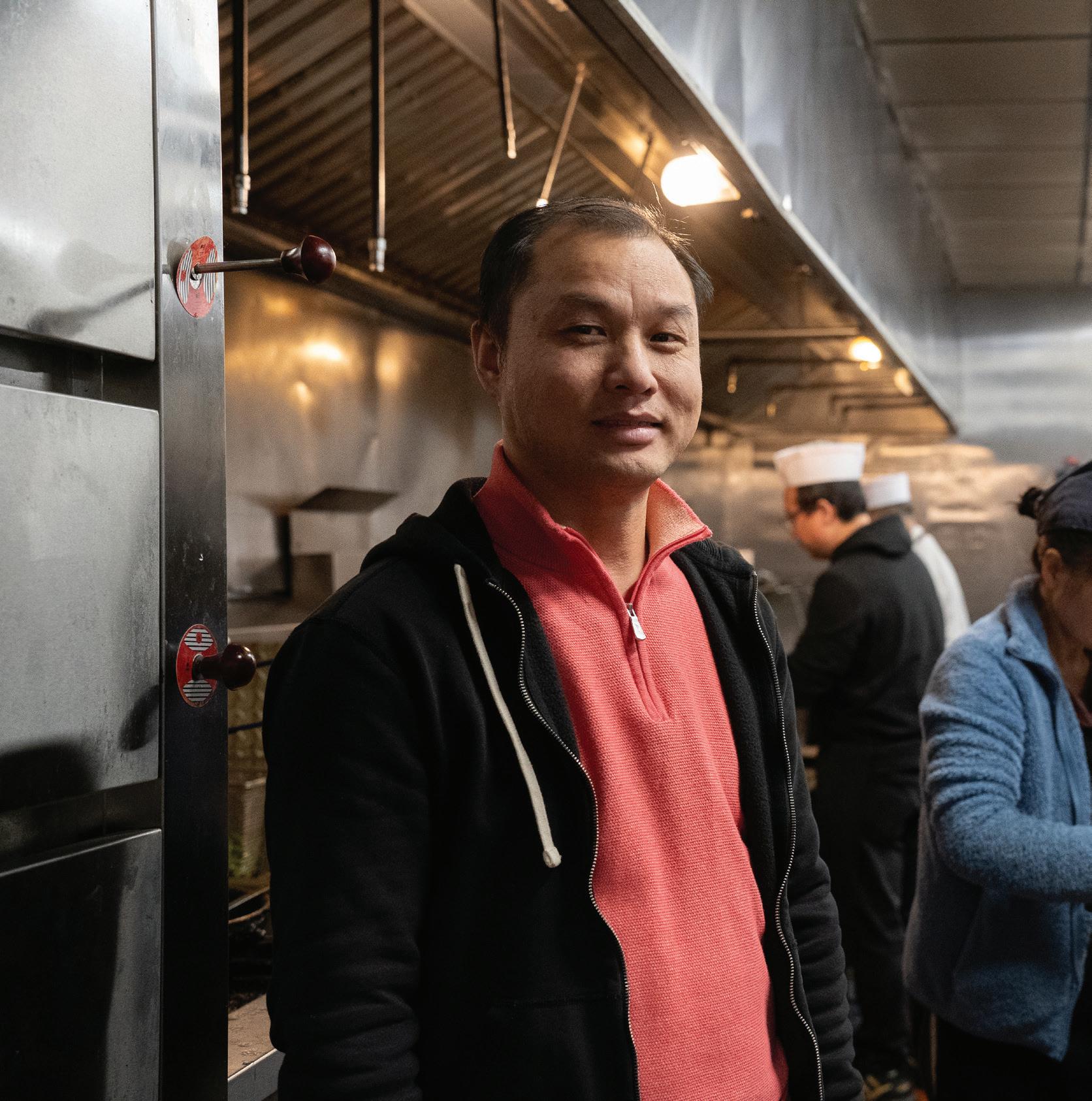
A writer seeks out authentic Chinese cuisine guided by Chef Jiang, the man behind his eponymous restaurant.
Everything at Chef Jiang seems designed to reflect light. The glossy wooden tables, the seats upholstered in shiny orange vinyl, the oversized oriental vases. Even the plates of food—hot, spicy, and glistening with oil—have become surfaces of refraction.
In one photo from a profile online, Chef Jiang’s owner, Jiang Zhongshan, wears a black chef’s uniform and a white cap, and he drapes his arm commandingly over the side of a chair. In person, however, he is quiet, slow-speaking, and straight-faced—in a black zip-up hoodie and white athletic shoes. He tells me that he spends most of his time thinking about the restaurant, its workers, and its customers. I ask him if he has any funny stories, and he shakes his head. I ask him if he has ever dealt with any bad customers, and he shakes his head again. He does not seem accustomed to talking about himself.
Jiang doesn’t speak English. The first thing the restaurant’s hostess asked me when I called to schedule an interview was if I spoke Chinese. I told her that I did. That is technically true. My Chinese is good, although not as good as it should be—which is to say, not perfect. Throughout my interview with Jiang—conducted entirely in Chinese—I sometimes have to ask him to repeat himself. He does so generously. Because we so often
hear about the pressures of the professional kitchen, it is easy to forget that cooking is a skill that takes a lot of forgiveness. Jiang watches as I stop in the middle of a sentence and wave my hands abstractly, searching for a way to rephrase my question. He says nothing, only smiles and waits.
Before Chef Jiang took up residence on 67 Whitney, the building was occupied by Great Wall Restaurant, a Chinese restaurant that closed down in June of 2023, after sixteen years of business. I ate there only once. It was their brunch special: a classic combination of soymilk, congee, and youtiao. I remember the tile floors and the overhead fluorescent lights. Because the restaurant was under renovation, my friends and I ate our congee out of small transparent containers with white plastic spoons.
In comparison, Chef Jiang incarnates a different, shinier version of the Chinese restaurant. “I wanted to have a place that felt modern,” Jiang tells me. Sure, there are still remnants of traditional Chinese restaurant kitsch—the neon OPEN sign in the window, a faint jazz cover of “Don’t Stop Believing” playing over the speakers—but for the most part, the space looks like something that has just been unwrapped from its plastic.
Jiang is as much a businessman as he is a cook. He tells me that every
aspect of the restaurant’s physical design was carefully planned and that food is only one part of the dining experience. Jiang understands something about his customers: they value the aesthetics of the thing almost as much as the thing itself. He shows me the restaurant’s Instagram page; one reel showcases shining interiors alongside shots of chow mein, dumplings, and fried rice, all filmed aggressively up close. The video cuts to a shot of orange chicken in time to the beat of Beyoncé’s “ MY HOUSE.”
Jiang grew up in Hunan, a province known for its spicy cuisine, and comes from a culinary family: his father was a chef, as was his grandfather. He attended culinary school and went on to work at an elite restaurant in Beijing. Hearing that economic possibilities were more plentiful in the U.S., he immigrated alone from China to the East Coast in his thirties. His wife and daughter joined him five years later, while he was working at a small Chinese restaurant in New Jersey.
“Not everyone who opens a restaurant will succeed. If you are lucky enough to have a restaurant, what’s the point in thinking, some fourteen years later, that you wish you hadn’t done it?”
A couple years ago, Jiang heard about a lease in Farmington and decided to open Chef Jiang’s first location in 2021. Whitney Avenue is his second location, which he selected in part to cater to Yale students. He has his eye on Providence—and Brown University—for his next restaurant.
I ask Jiang about his regrets; he says he has none.
“I’ve never really thought about it. I’ve never asked myself what I would have been if I hadn’t become a chef,”
Jiang tells me. “The journey was so hard—really, really difficult—and required sacrifice. Not everyone who opens a restaurant will succeed. If you are lucky enough to have a restaurant, what’s the point in thinking, some fourteen years later, that you wish you hadn’t done it?”
I don’t ask him about sacrifices. When we’re not talking about the restaurant, the conversation ends quickly— perhaps, it seems to me, because he doesn’t have much to say. He briefly mentions his daughter, Lily, who will be graduating high school in the spring. Even though they are no longer separated by the Atlantic Ocean, he doesn’t get much time with her between her schoolwork and his restaurants.
“We aren’t very close,” Jiang tells me.
On the weekends, Lily sometimes takes up shifts as a host and waitress. She is not as shy as her father. “He doesn’t speak to me much,” she says in English, after I ask her about their relationship.
Still, when Jiang stops by to check on us as we chat, Lily turns to smile at him.
“What are you talking about?” he asks us.


“We’re badmouthing you,” she says, laughing, and he places his hand on her shoulder in the specific way that fathers do: fondly and with weight.
When I ask Lily to describe her father, she immediately tells me that he is very serious. When I ask Jiang to describe himself, he thinks for a moment, and then says that he considers himself a kind person. This makes Lily laugh. Nevertheless, I think that I understand what he means. Jiang rises to bring me a mug of tea the second that I sit down to interview him. He insists that I take home some food after every meeting. He tells me that his favorite person to cook for is anyone who enjoys his cooking.
The dish that is most important to Jiang is not on the menu. A stir-fry of tofu and pork is too simple to be served at most restaurants. It’s a nameless food—the sort that people cook at home. My mom makes it; Jiang’s mother made it too. As a child, his family could only afford to eat the dish once a month. They bought the pork from a man who sold meat door to door, carrying it on his back with a wooden pole.
Jiang understands that food is situational and taste is temporal. His mother’s tofu dish exists in the past. It is the kind of thing to which he can never quite return.
Now Jiang tells me that he does not make the dish at home. He can never recreate the flavor.
“It wasn’t that the dish even tasted that good,” Jiang says. “But I was a little kid, and I only ate it once a month.”
Jiang understands that food is situational and taste is temporal. His mother’s tofu dish exists in the past. It is the kind of thing to which he can never quite return.
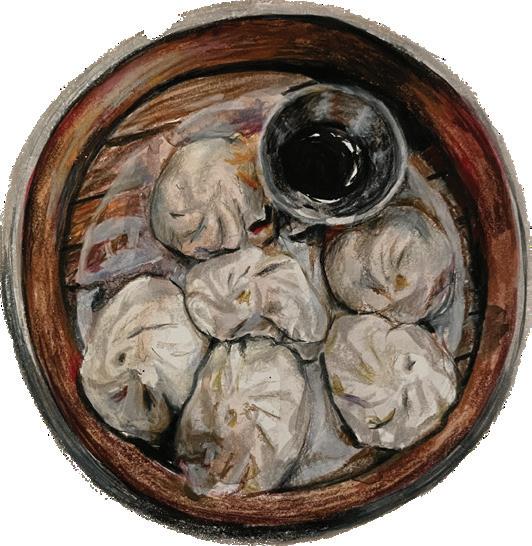
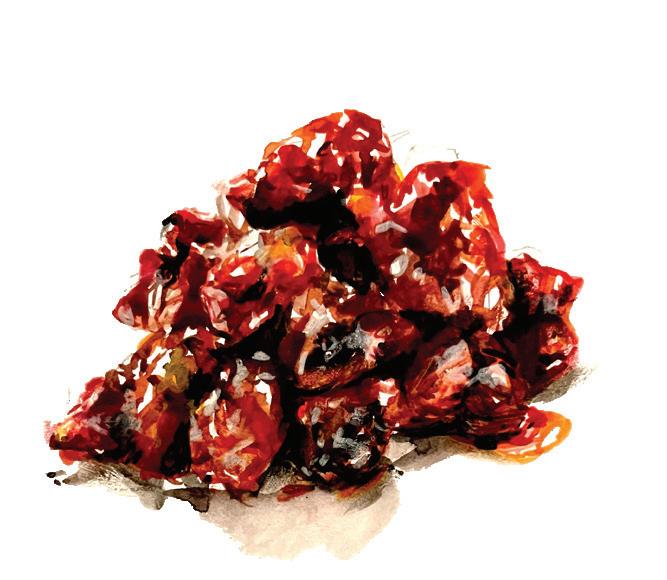
Igrew up eating at a lot of Chinese restaurants. These places were usually family-owned. They were almost always carpeted and decorated with fake plants. Some featured aquariums of large fish, and as a child, I was always worried that these fish were the same ones that would end up on the revolving table an hour or so later.
Among my family and our circle of friends, the highest praise that you could give a Chinese restaurant was to say that it was authentic. I considered authenticity the rallying cry against Americanized Chinese food, exemplified in my mind by chow mein and anything else served at Panda Express. It wasn’t even that I disliked Panda Express; in fact, I harbored a secret longing for its orange chicken and honey walnut shrimp. Still, I understood that enjoying “fake” Chinese food was the sign of being a “fake” Chinese person. The most hurtful insult of my childhood was whenever my dad, disappointed at my rejection of delicacies such as chicken feet or pig ears, would sigh and say to me, “I guess you really are an American.”
Articles reviewing Chef Jiang online make sure to highlight the restaurant’s more exotic dishes: gizzards, frogs, stinky tofu. I wonder if the perceived abnormality of these foods is meant to indicate their authenticity, as though the sign of a properly foreign meal is that it seems instinctively unappealing to the traditional American palate. I wonder, also, when Americans started caring so much about the legitimacy of ethnic food anyways.
Online, I watch a segment of a local news station from one month ago. In the video, Jiang stands alongside his marketing manager and two news anchors before four platters of food. “A lot of us are getting Chinese food, but we’re not getting the real Chinese food,” one of the news anchors explains.
That’s the selling point: authenticity. The food is real because the tofu is spicy and the fish comes with its head still attached. Jiang’s marketing manager tells the anchors that these are examples of dishes that Chinese people might cook at home, and the anchors marvel at how different this food is from the Chinese food that they had always known. Throughout the video,
I watch Jiang. He says nothing, just smiles and chuckles. Everyone else is speaking in a language that he does not understand.
...when we say that food is authentic, what we mean is that it tastes like something we have tasted before. That’s all it really is. Just the commonplace longing for something that you already know.
Jiang tells me that he adjusts his cooking to be more accessible for American customers. In addition to lowering spice levels, he has also included in his menu a section devoted to Americanized Chinese food staples like General Tso’s chicken and Mongolian Beef. Most American customers, he reasons, will first come to Chef Jiang for these familiar dishes. But
when they come back, they might try something more adventurous, and then they’ll keep coming back to try new things, and they’ll bring their friends along, and this is the slow process of teaching Americans what Chinese food really is, so that someday, maybe Jiang won’t need to put General Tso’s chicken on his menu.
In the meantime, though, he tells me that he isn’t particularly bothered by questions of authenticity.
“I just want people to eat here,” he says.
In Chinese, when you call something authentic, you say that it is dìdào. The word itself is constructed of two characters, one meaning “land,” the other “road.” This makes me think about how the concept of authentic cuisine never would have existed if people hadn’t traveled so far away from their own native lands. The original use of the term, dating back to the Ming dynasty, was actually as praise for products of a certain locale. Since then, however, dìdào has taken on an additional meaning: that which is
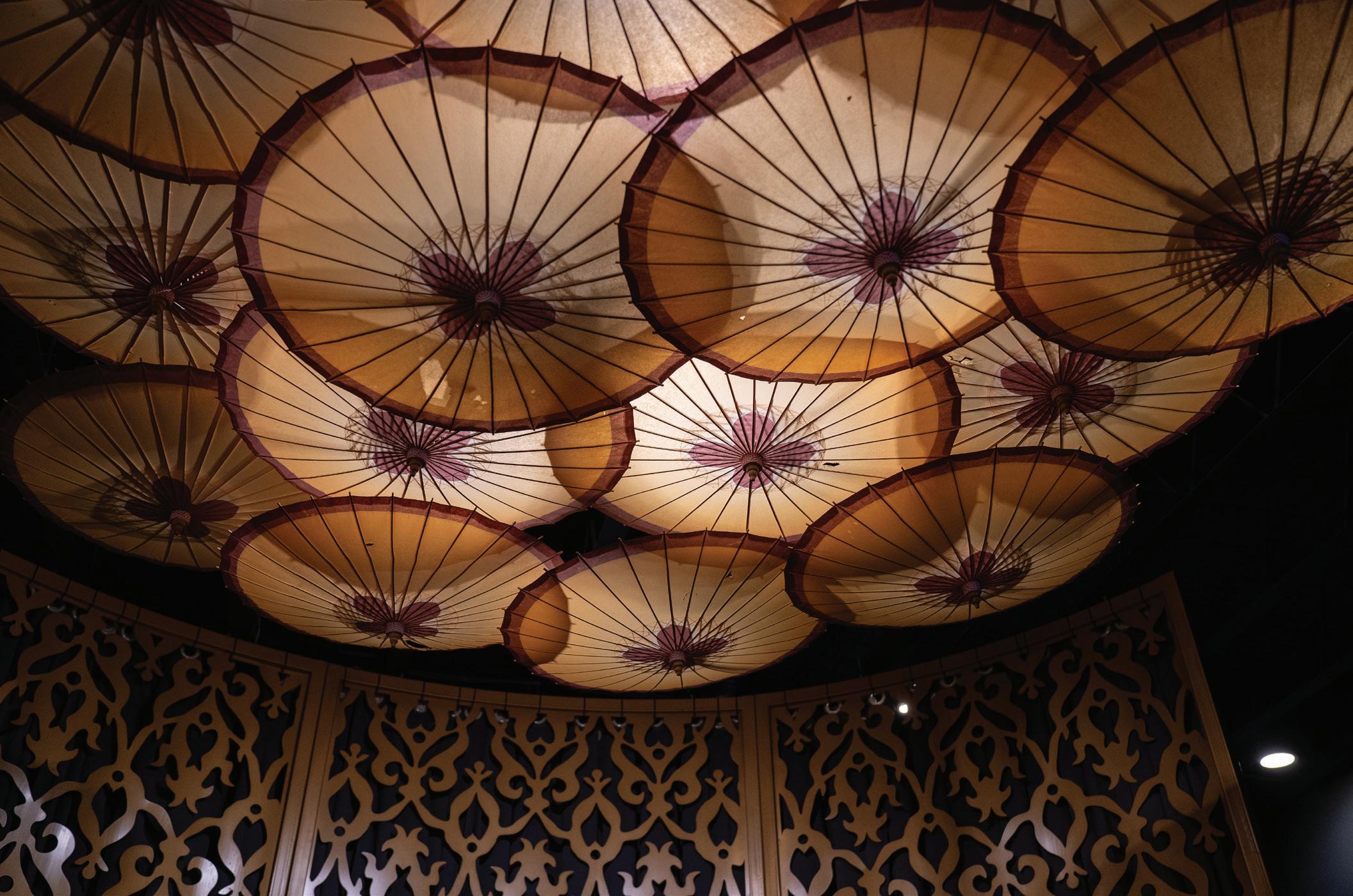
tangible or real. To me, there is something that feels so Chinese about this— the idea that truth must be intimately tied to home.
I eat dinner at Chef Jiang twice in the span of two weeks. The first time, I wait half an hour on a busy Saturday night to get a table with two friends, neither of whom are Chinese. We order scallion pancakes, chow fun, stir-fried lamb, bean sprouts, and Dan Dan noodles. As we eat, I find myself informing them that this is the good stuff, the real deal of Chinese cuisine. By the end of the meal, we are exhausted—both from eating and from talking about how excellent the food is.
My second dinner at Chef Jiang is during the Lunar New Year, upon the invitation of a family friend—a Chinese professor at Yale. She is from Shanghai and is probably the best cook I know. I ask her how she recognizes when a dish is authentic or not. “I only really know if I’ve had it before,” she says, which I understand as her graceful way of telling me that my question is a poor one.
In the middle of dinner, I take a quick trip to the bathroom. In one corner, there is a palm-like plant in a dark
blue ceramic pot. I reach down to press my fingers against the roots. I feel the smoothness of the plant and the softness of the dirt. It’s real.
After our first interview, Jiang insists that I bring some food back to my dorm. From the menu, I select the wontons in chili oil, which he packs up for me in a black plastic container.
If you want to know the truth, I have no idea if the food at Chef Jiang is authentic or not. I haven’t been back to China in close to ten years. When I go out for dinner with my non-Chinese friends and try to explain whether the scallion pancakes are real or unreal, it’s an exercise in bullshit, the indulgence in a feeling of expertise that I can claim and others cannot. This is one of the pleasures of tribalism—the ethnic secret, the esoteric knowledge, the self-aggrandizing idea that my taste buds actually do have some instinct for truth.
We never even made scallion pancakes at my house. Instead, we bought them frozen from the Chinese grocery store and heated them with slices of cheddar cheese melted blasphemously on top.
…that summer and the swollen pregnant heat, when Isa and I would walk around the house in our underwear and spend our water bill in the cavities of those hard plastic ice trays, that summer when I had two jobs and there was no poetry left in me by sundown, that summer when we’d keep the windows cracked open and every Saturday the dirt bikers would roar down the road and rattle all of our mismatched kitchenware, that summer I let seashells collect on the bathroom window, that summer I broke the wheels of my parents’ best suitcase bringing thirty-five books back to the library, that summer I waited for you to drive up to me on the weekends, that summer I started a fire by the lake and all of my clothes smelled like smoke and clean tobacco, that summer the man started following me, that summer the shape of my body changed, remember that one?
—Lucy TonThatBut when I sit on my couch and eat Jiang’s wontons, I remember making wontons at my kitchen table, and also the restaurant back at home where my mom used to order this same dish for me after school. I think about how these wontons taste like something familiar. And how, when we say that food is authentic, what we mean is that it tastes like something we have tasted before. That’s all it really is. Just the commonplace longing for something that you already know.
“Exactly,” Jiang says, when I try to explain all this to him at the end of our last interview. He nods at me, as though in approval. “Authenticity is just what we say about something that makes us think of home.” ∎

She believes in the Virgin the way I believe in the mountain, though in one case the fog never lifts.
But each person stores his hope in a different place.
– Louise GlückI went to the service because I wanted to sing hymns. My sophomore fall had been a warm one. I spent it reading into texts from a girl I wanted to be with, drinking purple gin and minty tea, and not thinking about any higher power. I hadn’t been to church since I declared my atheism at 13. But then it was December. I was alone, and the afternoons were dark. I wanted music that sounded like light.
I dragged my friend Lucy to the Christmas service on campus. We sat on the balcony. Below us, poinsettias lined every aisle and window sill. Their symmetry pulled the music into a new sphere; the air seemed to purr. Before “Silent Night,” we watched the light unfurl candle by candle, each congregant passing their flame to the next. I let wax drip onto my fingertips. We pretended not to notice the shake in each other’s voices.
After the service, we ate takeout and Lucy read me a poem by Ada Limón:
And I think of that walk in the valley where J said, You don’t believe in God? And I said, No. I believe in this connection we all have to nature, to each other, to the universe. And she said, Yeah, God.
We pasted this into a document and named it “religion.” Today it is thirty-nine pages long, filled with prose
and poems written by women we love. We add a piece of writing if it makes us feel this connection we all have: to nature, to each other, to the universe.
Igrew up in a small country church, sharing hymnals and communion grape juice with adults who had been sitting in the same pew since childhood. Maybe, as we sang together, they were connected— to nature, each other, the universe. I certainly was not. Church taught me to remember grown-ups’ names, to speak in front of a crowd, to bake muffins for coffee hour. But I understood religion as something to memorize. I learned the Lord’s Prayer as soon as I could read, because a cross-stitched reproduction was the only thing hanging on the oatmeal-colored walls, and my eyes longed for an interesting place to rest. Each spring, at the end of the Sunday school year, we recited the titles of the books of the Bible before the congregation. I still remember the groupings of syllables, but I can’t keep track of the order of the clusters. Psalms, Proverbs, Ecclesiastes. Joshua Judges Ruth. They didn’t mean anything to me then; they don’t mean anything to me now. Just sounds for my wandering mind to chew.
But the scriptures Lucy and I have compiled don’t feel like syllables to memorize—not the hollow words of the Lord’s Prayer or the repeated books of the Bible. Every entry rips my stomach open.
In March, Lucy and I went to Paris, to feel grown up. I dragged her to the Sainte-Chapelle to see the stained glass. We marched up the shadowy spiral staircase, heaving closer and closer to the heavenly glow. But the sky was too cloudy. The glass did not glow. We tried to parse out the Bible stories told across the windows—maybe that, there, could be a crucifix?—but we could not orient ourselves. We spotted one woman in all of the thousands of window panes. I told Lucy that the space still felt sacred, but I was mostly trying to convince myself.
In the Musée D’Orsay, we looked for Berthe Morisot’s oil paintings—she’s our favorite. We turned a corner, and our breath caught in our throats. In the frame, a blonde girl placed flowers into the hair of her brunette friend sitting in front of her. It was called L’Hortensia and neither of us had seen it before. We did not speak. We did not need to say aloud that we were looking at a picture of us—that we were seeing, through Berthe’s paintbrush, the tenderness of our friendship. Sacred.
I lived near a Cape Cod beach for forty days when I was 19. Every afternoon, I stood in front of the water and waited for the ocean to make me feel small, to lull me into a sense of connection to the earth. Every afternoon, I thought about the people who had stood in front of this same water and felt the same smallness, the same connection.

19-year-old girls in fifteenth-century Spain, across the ocean, staring back— every afternoon, I felt connected to them.
Two years later, at 21, I spent a month in France with twelve other students who wanted to write. We were living in a town called Auvillar. Pilgrims walking the Camino de Santiago pass through this town on their way to northwestern Spain. When they reach the coast and look out toward the Atlantic, they face, almost directly, where I stood on Cape Cod.
Église Saint-Pierre hosts a church service each night for anyone passing through Auvillar. I joined on a Wednesday,
taking a moment away from trying to nail to the page places and people and purring air. The priest blesses the pilgrims, giving them strength for their next day of walking. How many have come before them, dirty feet on this same weathered ground? How many have walked, and walked, and walked, have given their body over to aching hips and raw skin to serve something greater? How many have doubted themselves and their God in the heat of midday? And then: how many have sat in these pews, where I sat one Wednesday in July, and had a priest tell them to keep walking, to keep going, that they are doing
the right thing? That bodily relief—reassurance flooding out pain—that, I think, could feel like God.
When I stand in a church, I do not feel God. I do not feel a Father, or a Son, or a Holy Spirit. I feel the people who have stood there before me and looked for something beyond themselves. Who took meaning and comfort from these walls, and from the words and the music—and maybe from the God—that echoed in the vaulted marble ceilings. I am not interested in the Bible—until I think about the people who have turned to it for answers. These people: their existence moves me. It moves me to stand in this place where they stood, to read these words that they read, to let go of my body as they let go of theirs.
I have always been too sensitive, Ada Limon writes in a different poem. A weeper from a long line of weepers
In Charlotte Brontë’s Villette, Lucy Snowe—fiercely Protestant—falls into a depression and stops eating. She confesses to a Catholic priest and then has a religious breakdown on the steps outside the church. Every time I read the scene, I wonder if she collapsed from low blood sugar. Feel it in the body, name it to a god.
Idid think that I felt God one time in my childhood church. Our choir director, Sue, and her son had not spoken in many years. The son was coming for Christmas to mend things and to watch our yearly pageant. But there was a snowstorm, and his travel was disrupted, and he was stuck in New York. No public transportation could get him to town before Mary gave birth.
So a deacon named Don drove through the snow, three hours each way, to pick him up. In the middle of the pageant, when a little lamb was singing, the door exploded open. The music stopped. Every head in the room turned to the door, and then to Sue. She looked at her son, smiled, and kept conducting. And we all kept singing—faces a little brighter, eyes a little damper.
And maybe it was God. But now, all that I can remember is Don’s virtue, and Sue’s music, and the relief of a lot of people who wanted good things for each other. ∎
Madeline Art is a junior in Trumbull College.
Connecticut became the first state to mandate an ethnic studies elective in high schools. How are New Haven teachers and students navigating the curriculum?
 By Chloe Nguyen
By Chloe Nguyen
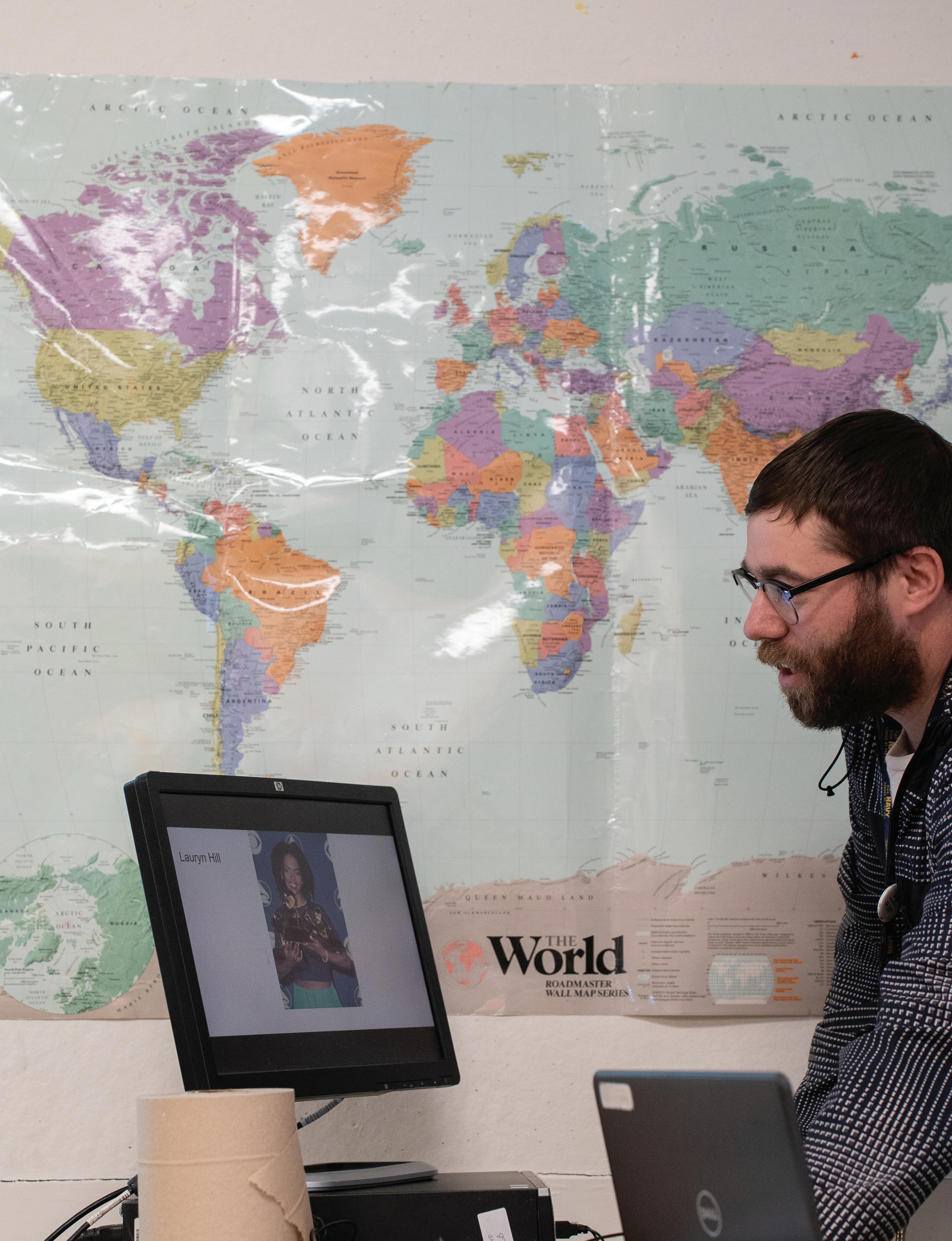

It’s last period, and students in Ryan
Borowski’s “African American/Black and Puerto Rican/Latino Studies” stir with anticipation: not of dismissal, but of their in-class assignment. Students have eyes locked on their notes instead of the clock. One high schooler motions to open the conversation. Borowski reminds the delegates to shake hands out of respect for debate and for differences of opinion.
“Terrorism is an unlawful use of violence against civilians,” the student begins. For fifty minutes, a classroom of nineteen high school juniors and seniors debate the legacies of abolitionists John Brown and Nat Turner. Each team huddles around their respective table, where they hurriedly jot notes to argue whether the men should be remembered as martyrs or terrorists.
“Maybe violence was the only answer they had,” one student ventures from the four speakers’ chairs, clustered in the classroom center. “They admitted to murdering people who might not have had a place in this,” another student rebuts, “Martin Luther King [protested] peacefully…there were better ways to do this.”
Between designated speaking times, delegates deliberate these violent rebellions with their peers.
“Was it inevitable?” “Was it just?” Through the thicket of conversation, I hear mentions of the Emancipation Proclamation, Al-Qaeda, and congressional hearings. The upperclassmen’s arguments pull from a vast bank of historical knowledge.
When College Street car horns start blaring, the students peer out the window to investigate the commotion. Borowski quickly pulls the room back to focus. “I have no clue what goes on in downtown New Haven,” he says, “We can only control what goes on in here.”
Borowski moves the conversation into modern terms, comparing the violence perpetrated against Planned Parenthood centers to the violence perpetrated by Nat Turner and John Brown. “[Are] those people in modern times that use violence at Planned Parenthood places…justified in their actions because they are also acting on behalf of what they think is right?”
Five years ago, this debate would likely not have occurred in a Connecticut high school classroom. Borowski has been teaching the state-mandated ethnic studies class at the Cooperative Arts & Humanities Magnet High School (Co-Op) in New Haven since 2021. The elective is composed mostly of juniors and seniors who are interested in learning about Black and Latino histories. A 2019 bill made Connecticut the first state in the country to mandate the inclusion of ethnic studies electives in its high school curriculum. Classes like Borowski’s are available to high school students across the state.
The same year Connecticut piloted the country’s first state-mandated offering of a Black and Latino studies elective, ten states—particularly in the Midwest and the South—passed censorship bills to ban “divisive” discussions of institutionalized racism and Critical Race Theory in both K-12 and college classrooms. Americans have long been conflicted on how to teach race and history in classrooms. These most recent debates follow a long lineage of “culture war” rallying cries on topics ranging from religious education, sexual education, LGBTQ + rights, and racism that often play out in schools. Educational initiatives that question Eurocentrism, cultural relativity, and the democratic principles of the founding fathers have Writing in the Margins

sparked backlash from outspoken critics (in 2019, The New York Times’ “1619 Project,” which asserted that America began when the first enslaved Africans arrived, was countered by “The 1776 Project,” a conservative retelling of history since America’s founding). The fixation from all parties reveals that schools are more than just spaces to transmit knowledge; classrooms can be battlegrounds for defining America.
Including Borowski, I spoke with four New Haven Public School teachers, a dozen of their students, and an additional nine advocates about the passage of a bill that has the potential to set a precedent for public education in America.
On june 21, 2019, governor Ned Lamont approved the incorporation of “Black and Latino Studies” in the Connecticut public school curriculum
with the passage of Public Act No. 19-12. The bill received strong support across parties, with a vote of 122-24 in the Connecticut House of Representatives Borowski attributed the bill’s near-unanimous endorsement to Connecticut’s strong Democraticleaning demographics: “I think [our] side of politics is not afraid to learn true American history, and other states are.”
Though the act passed with little resistance, it took advocacy from students, teachers, and parents to push the issue to the legislature and ensure its efficacy.
Benie N’Sumbu, a 2019 graduate of Co-Op, testified in front of the Education Committee to support an earlier iteration of the bill in the spring of her senior year. On behalf of Students for Educational Justice, a youth-led advocacy group based in New Haven, N’Sumbu expressed concern about how Black history was taught in school: “Just a few years ago, people were talking about how slavery was a choice and how they didn’t fight back, which is so not true.” She hoped the course would
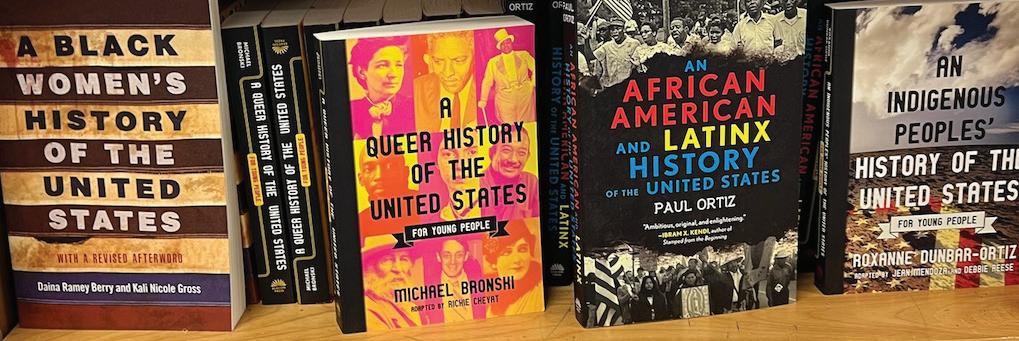

introduce an “untaught history” to schools, with lessons that could challenge biases in conventional curricula through active student engagement, not simply “fact regurgitation.”
N’Sumbu’s sentiments were affirmed by the results of a 2020 survey conducted by the curriculum’s Advisory Group: a third of Connecticut high school students polled were interested in acquiring “a deeper understanding of inequalities and understanding of racism as a social construct.” According to survey results, students were particularly interested in learning the “real” history.
From 2019 to 2021, the State Education Resource Center (SERC) partnered with the Connecticut State Department of Education to develop a curriculum for the new course. SERC members said they hoped to create a program that would set a new precedent for learning, deviating from a Eurocentric framing of Columbus’s New World landing and European colonization as the start of American, African, and Latin American history.
During the program’s development, rising instances of police brutality and subsequent protests made systemic racism more visible and Critical Race Theory a popular debate in mainstream media. In Connecticut, right-leaning politicians and parents rallying against the program weaponized misconstruals of Critical Race Theory against educators who were attempting to elucidate race, racism, and identity in K-12 classrooms, particularly in wealthier suburbs. In Easton, residents put up anti-CRT signs, and in Guilford, nearly five hundred people petitioned to ban social-justice indoctrination in their public schools. Schools even struggled to run the course because of a lack of student interest, having to offer half-year iterations to improve enrollment.
The State Board of Education approved the final course, “African American/Black and Puerto Rican/Latino Studies,” on December 2, 2020. The curriculum was not approved solely to cover racism—N’Sumbu and her co-organizers at SEJ were concerned that a class with “Race” in its title would not pass statewide. But consultants at SERC told me they had every intention of creating a new type of class to address the history of racism in the U.S.

The course intends for students to work intimately with the material. Most of the assessments are journal- or discussion-based, culminating in classroom essays and debates. Only twice does SERC’s curriculum mention the word “quiz,” and never “exam.” Paquita Jarman-Smith, the SERC Consultant responsible for the African American/ Black studies portion of the curriculum, said that she and her colleagues prioritized activity-based learning to engage students beyond memorizing facts. The curriculum also outlines a semesterly class project, where students collaborate with other school departments, like Art, Music, and English Language Arts, to creatively present their imaginings of justice based on the year’s teachings.
Starting in the 2021 to 2022 academic year, school districts across the state of Connecticut were invited to teach the pilot program. The yearlong course was divided into two semesters. The first chronologically taught African American and Black history, from ancient African kingdoms to the Jim Crow era to the modern Black Lives Matter movement. The second centered a thematic focus on Puerto Rican identity, a demographic that represents 74 percent of the Hispanic population of Connecticut, and Latino Studies, touching on Indigenous erasure by Spanish colonizers, U.S. colonialism, and the diversity of Latino identity. In the fall of 2022, all Connecticut high schools were required to include the elective in their offerings.
The developers of the course expressed their pride in this achievement, saying, “Each day we are just enamored with this.” When asked about the feedback they received on the program, JarmanSmith, Diaz, and their colleagues at SERC agreed, “All students should have this course.”
Student organizers, serc, and their Advisory Group felt that pushing for all schools to require the course would have placed excessive pressure on its broader school districts. This is especially true in light of Connecticut’s recent amendments to high school graduation requirements, where students need to obtain twenty-five credits instead of twenty credits to graduate. Legislators and organizers hesitated to impose further changes on schools.
With the course ultimately being an elective, however, the educators I spoke with were concerned that not all students can make room to take it.
“Electives compete with other classes for students,” said Ben Scudder, who teaches the course at High School in the Community. “Students are picking between this and P.E. or art.”
Moreover, they voiced concerns that it would self-select students with prior interest instead of those who already felt disconnected from the material. Throughout the New Haven school district, 89 percent of students identify as non-white, with 48.1 percent of all students identifying as Hispanic or Latino and another 35 percent identifying as Black or African American.
Jessie Piper, who teaches the class at Metro Business Academy, noted varying levels of interest in the course. Piper told me not all students in her class take it on their own accord; some are placed by guidance counselors for scheduling purposes. “I’m worried that the people who don’t care will weigh down the people who do care,” she said. Moreover, the class was designed to be inclusive to students of all learning levels, so some students with less prior knowledge might have to learn the material at a faster pace than others.
Still, each of the four classrooms I visited had students who attested to the value of the course.
Borowski’s junior students at Co-Op affirmed the class’s in-depth nature. Farida I., one student, spoke on the curriculum’s ability to transform challenging topics into accessible ones. “It’s a mix of jokes,” Farida said. “Then we get into the serious stuff, then we cool down and discuss.”
Drew S., a sophomore in Piper’s class at Metro, found the second-semester curriculum especially rewarding. Growing up Black in the South, she had accumulated a knowledge of Black American history but had received less exposure to Latino culture. She cited the Mexico-U.S. border system, Christianity’s diffusion throughout Latin America, and the tenuous relationship between Puerto Rico and the U.S. as crucial facts the course had taught her.
But Drew also expressed confusion on why this cultural history course was separated from the core U.S . History curriculum. “It’s kinda ridiculous that we even have to have this class when this history is literally American history,” she said. “Why is this not just a part of the regular history curriculum? It’s like they’re othering [people of color]. It’s like ‘This is the history, and there’s no room for you.’”
I visited A’Lexus Williams’s classroom at Hill Regional Career High School the same day I visited Borowski’s classroom: February 1, coincidentally the first day of Black History Month.
That day, Williams had created a presentation for the last unit of the first semester, “Protest, Politics, and Power (1965-Present).” It included songs like Sam Cooke’s “Change is Gonna Come” and Marvin Gaye’s “What’s Goin’ On,” and a 1964 speech by Martin Luther King Jr.
Williams weaved through every corner of her large classroom to address her eleven students. She moderated the discussion closely, but many of her students were excited to jump in.
Williams, who is Black, confidently projected to her class of entirely Black and brown students. On the whiteboard, she defined the word radical and said: “The audaciousness for Black people, free and enslaved, to call for the abolishment of a system that had been sustained for hundreds of years was considered radical.”
Wesley R., a senior in Williams’s class, felt the class was more freeing than the fast-paced STEM lectures he was used to. “Our ideas just come out, and we talk based on what a peer might say,” he said. “In other classes, we’re quiet unless a teacher picks on us.”
Later that same day, Borowski and his students conducted their final debate of the semester, projected in front of the room: “Were John Brown and Nat Turner American martyrs/heroes or terrorists?” Through laughter and earnest deliberation, Borowski’s students all participated in the assignment with uniform engagement and enthusiasm.
On the same day, following the same state guidelines, Williams and Borowski taught two different classes in two different styles.
“We offer and guide [Connecticut schools] to follow the course and follow [its] fidelity,” SERC’s Jarman-Smith told me. “But school districts have to make it theirs.”
A few years prior to teaching this course put forth by SERC, Borowski and his colleagues had been asked by Co-Op principal Paul Camarco to develop and teach a class on African American and Black history. Borowski developed the course, which he recalled teaching from 2017 until 2021, by asking his students what they envisioned. The result emphasized modern figures and events, a practice that he has carried into implementing SERC’s program.
“[Students’] personal experiences tend to relate more to current events and injustices,” Borowski said, “police brutality, mass incarceration, war on drugs…”
Straying from the statewide curriculum, Borowski asks his students to research examples of modern-day slavery or the stories of unheralded Americans like queer activist Marsha P. Johnson. He wants his students to discover what makes them curious, and what makes them uncomfortable: “If you give students meaningful choice [over] what they learn, they’re more likely to take ownership of their learning.”
This style seemed to resonate with some of his students. “[The content] is not just facts and dates, which don’t connect with me easily,” Juliet S., a senior in Borowski’s class, said. “We talk about the mistakes of the past.”
This standardized curriculum can look so different between two schools in part because following SERC’s program in its entirety can be overly ambitious for educators.
“The curriculum is so dense [and] pacing in the curriculum underestimates certain lessons,” Williams said. Scudder and Piper agreed that it is infeasible to cover all the content in one year.
As a consequence, teachers have assumed the liberty to modify lesson plans according to their educational interests and understanding of their students’ learning paces. “I’m looking at it as a course that opens a lot of opportunities,” Scudder said. “It’s not beholden to anything; there’s no AP exam at the end.”
The class looks different everywhere. Teachers facilitating the course throughout New Haven public schools don’t communicate directly—when asked if they knew anyone else who taught the course, the teachers I spoke to struggled to come up with a name from any of New Haven’s nine public high schools. According to Williams, the history departments across the schools meet once a month for only an hour. There is no set time for the African American/ Black and Puerto Rican/Latino studies teachers to meet. As a result, the program can vary in content, pacing, and methodology from county to county, school to school, classroom to classroom.
Despite this lack of inter-district communication and consistency, Williams noted a shared experience among teachers in the district. “We’re definitely on the same page on how dense [the program] is, but we have to do what is in the best interest of who is in front of us.”
Public Act No. 19-12 does not mandate an additional certification for teachers to instruct the course—any high school social studies teacher can teach it. But in its public digital copy of the curriculum, SERC publishes hyperlinks to databases, articles, and activity lesson plans. It also hosts a summer institute, quarterly trainings, and an end-of-year showcase to prepare teachers and track progress.
Williams opted to attend a professional development seminar hosted by the Anti-Racist Teaching & Learning Collective (ARTLC). The initiative is a collaboration between Yale professor Daniel HoSang; Students for Educational Justice; Hearing Youth Voices, a youth activism group based in New London; and local educators. Members of ARTLC had expressed a wide array of concerns about the bill: that it would mandate an inflexible curriculum that would “displace existing teacher-developed courses,” fail to prepare teachers, employ ineffective and impersonal methodology, and silo African American and Latino Studies with each semester’s
structure. ARTLC offers solutions in their anti-bias and anti-racist oriented teaching guides, lesson plans, webinars, and in-person seminars for those teaching the course.
Williams acknowledged how ARTLC’s resources help empower teachers to feel comfortable having the difficult conversations that emerge from course questions. “Having that [professional development] allowed my white colleagues to think it is okay to maybe say the wrong thing,” Williams said. “Now they know how to move forward. We’re not gonna get into that white defensiveness.”
Scudder and Piper also mentioned finding these resources through colleagues and friends who were already involved in ARTLC. Similarly, Borowski expressed taking additional steps to learn beyond the scope of SERC’s recommended training, such as researching books to include in his lessons, like Dear Martin by Nic Stone and The House on Mango Street by Sandra Cisneros.
“Training is like ‘Let’s go through the curriculum in a week,’” said Scudder. He said the difficulty of the topics is not matched by the quality of training, which largely reiterates SERC’s publicly available material. To him, this cannot sufficiently compensate for every background discrepancy. “I didn’t major in Black or Latino history,” he said. “I majored in political science…There needs to be a greater discussion of what this class will look like.”
The deeply personal themes of the course, paired with varied implementation and levels of training, mean that student experience depends more than usual on who is teaching and how.
While 89 percent of the students in New Haven Public Schools are non-white, only 28 percent of teachers are non-white. Williams was the only nonwhite teacher I spoke with.
This discrepancy is no anomaly in the history of New Haven Public Schools. N’Sumbu said she never had a Black teacher in her time at Co-Op. Drew added that the students are aware of this disparity: “Especially with the history that we know between white people and Black and brown people, it feels questionable at times to have a majority Black and brown school and basically, all the staff be white.”
This divide is not lost on the history and social studies teachers of New Haven. Borowski said that for his class’s first discussion, he wrote a question on the board: “How do you feel about having a white teacher teach this class?” While he received a mixture of positive, neutral, and negative responses, Borowski took the opportunity to hear his students and, together, negotiate best practices for learning heavy content.
Juliet, who is Persian and one of the few students in Borowski’s classroom to not identify as Black or Latino, told me, “Borowski makes it very clear that we all have a voice here.”
Piper had also welcomed the subject into her classroom. “You’re white and why are you teaching
Writing in the Margins

this class?” she tells me her students have asked. She says she responds: “It’s history, and you don’t have to personally live history to talk about it.”
One of Piper’s senior students, Alysian M., said she’s glad that Piper is the one to teach the course. Alysian identifies as a biracial trans lesbian, or, as she puts it: “a lot of different identities hodgepodge together.” Alysian sees her own history in the course, in discussions of struggle ranging from African American history to the Haitian Revolution.
“Learning about [slavery] makes me feel closer to history and people around the world and struggling with an oppressor,” she says. “Despite race, nationality, gender, and sexuality, everyone has had somebody who’s bullied them…Overcoming that oppression, that’s what attracts me to the course.”
As students learn, the teachers in front of them consider their own roles.
“I’m trying to think of myself as less [of] a teacher and more as a facilitator of discussion,” said Scudder, whose sentiments were shared by the other white teachers I spoke with who are teaching the course.
Williams, who is one of two women of color in her seven-person department, believed that that attitude might distill classroom discussion. “The white teachers who are teaching this course probably are worried about saying the wrong thing or don’t know how to have these conversations about race,” she said. “They don’t want to upset their students or perpetuate something.”
Wesley noted how that representation was important to him and his classmates: “[Williams] is someone who has felt disparities…since she looks like us, we feel like what we’re being taught is more personal in that way.”
But regardless of background or identity, Williams acknowledged that everyone has something to learn from the course. “I’m the first to tell my students that just because I am Black does not mean I know everything about Black history because we are not monolithic,” she said. “There are things that I’m learning and unlearning and considering other perspectives as we go through this together.”
Williams recalled an unexpected learning experience for her in her classroom. One day, she presented a recent court case to her class regarding a Black student who was suspended by his Texas high school for refusing to cut his hair. She intended for the case study to demonstrate the future of Black excellence and beauty, incorporating the idea from previous units of race as a construct. In response, one of Williams’ students asked whether or not he would cut his hair when he entered the workforce. Williams was surprised how susceptible her students were to messaging around “what is proper, what is presentable, who gets to decide.”
For Williams and her students, her deviation from the original lesson plan became an opportunity to illustrate how the course’s significance transcended arbitrary facts and grades. In Williams’s classroom, the course served to bridge the sometimes wide divide between the student and the individual.
Though teachers had various interpretations of the course, they shared recognition of its value.
Borowski described this class as an opportunity to promote interest in educational careers, saying, “We want to push more of our students to become teachers.” Borowski highlighted the importance of representative curricula and teaching, considering he is positioned as a white educator in a predominantly non-white community. “This course can be a unifier if done correctly.”
While Williams had apprehensions about having a “real” history course being situated outside of the popular U.S. History curriculum, she approved of what was available. “If they’re not going to completely rewrite and review the U.S. History curriculum,” she said, “then yes, this course does do well to stand alone.”
To Williams, though the course itself leaves room for improvement, it represents something invaluable. “I think this course in particular hopefully allows students to connect to not just content in a more authentic way but really see we’ve all contributed something to make this nation what it is. There’s good and bad and ugly everywhere, but there’s so much value in being able to explore these things together.”
“The mere existence of this sends a message,” Williams said, “that it is important, that it matters, that it is U.S. History.” Connecticut’s students and teachers are the proof. ∎
Chloe Nguyen is a sophomore in Saybrook College and an Associate Editor of The New Journal.
Under a complicated national tax filing system, New Haven residents and Yale students come together at the downtown Volunteer Income Tax Assistance site.
By Ai-Li Hollander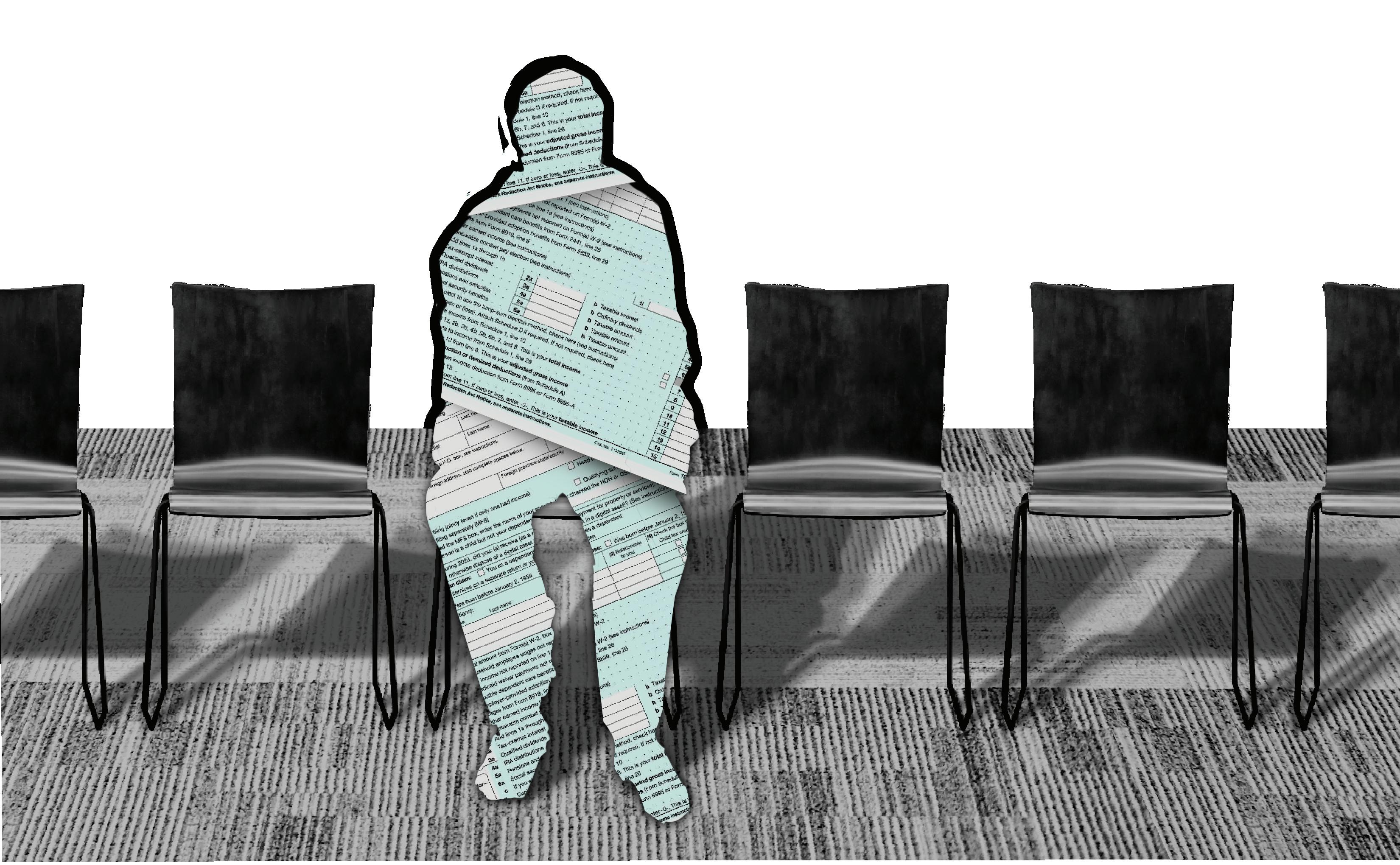
On a cold February afternoon, ten people scatter among identical rows of chairs in the basement of the New Haven Free Public Library (NHFPL). Between the patterned surfaces, diffusely lit by the overhead fluorescents, the room hums with noise. It is an hour and a half before the opening day of the Volunteer Income Tax Assistance (VITA) site, which operates as a branch of the Internal Revenue Service’s national VITA program. Here, at Connecticut’s largest VITA site, Yale students run the operation.
Thirty minutes before the site officially opens, Yale student volunteers wander in. With widened eyes, they scan the waiting area for their fellow students,
now full of clients. Last year, the site brought more than $2 million back to New Haven and helped more than a thousand people file for free.
While helping taxpayers avoid costly tax preparation fees, VITA sites also aim to increase access to tax credits like the Earned Income Tax Credit (EITC) and Child Tax Credit (CTC). These credits are part of the complicated web of programs that define the United States’ social welfare system. However, claiming them is difficult for those without a professional accountant or online tax preparation services. Out of the one hundred and forty eight million individual tax returns filed in 2020, only a little more than four
million were filed for free. Without the time or energy to parse through the code by hand, the most economically disadvantaged people—including those who do not speak English—bear this bureaucratic and administrative burden the most. As a result, these social benefits often do not reach those who need it. Many New Haveners stand to benefit tremendously from the money these credits put back in their pockets. According to Census data, 21 percent of New Haven residents live under the federal poverty line.
Every year, around 20 to 25 percent of Connecticut residents eligible for the EITC do not claim it, according to IRS
estimates. Additionally, an estimated two-thirds of those who miss out on significant EITC returns nationwide are those who choose not to file because they are below the income threshold that requires them to submit a tax return. In Connecticut, the average EITC return was $2,294 for the 2022 tax year, a significant boost for taxpayers. Reporting by Annie Lowrey in The Atlantic argues that these tax credits mirror a larger trend in social welfare: benefits are shrouded in a sprawling, dysfunctional, and complex web of programs that obscures access for those who need them the most. People who do attempt to claim these benefits face time-consuming bureaucracies, invasions of privacy, and the stigma that surrounds social welfare.
VITA serves as a strange band-aid to these gaps, tasking volunteers with the intimate business of interacting with clients one-on-one and handling their Social Security cards, government IDs, and financial documents. On Yale’s site, the impersonal bureaucratic system becomes personal, at once highlighting the people behind the tax code and the barriers to access of the current system.
When I spoke to John DeStefano Jr., Mayor of New Haven from 1994 to 2014, he framed the VITA program as a matter of civic duty, for both the volunteer and the taxpayer. Volunteers give back to their neighbors “in a very traditional social contract sort of way,” while taxpayers contribute through their tax dollars. DeStefano emphasized that this definition of citizenship includes undocumented people, who can pay taxes through the acquisition of a Tax ID number and utilize VITA sites to help them file.
When I asked DeStefano about the barriers people face to filing taxes, he remarked, “I think that some things are complicated,” acknowledging that language differences can exacerbate these challenges. However, he equated filing taxes to getting your driver’s license or passing a driver’s test. “I really don’t think that’s too big of a burden to expect of people,” DeStefano said.
VITA leadership repeatedly told me that a significant challenge they face in providing effective service is language barriers. According to Census data, 20 percent of people speak Spanish in New

Haven, including those who may be bilingual. Co-President Wendy Zhang ’25 acknowledged difficulties in recruiting enough Spanish-speaking preparers, challenging VITA’s ability to provide the accessible services they aspire to. The Yale student volunteers and clients
On
Yale's site, the impersonal bureaucratic system becomes personal, at once highlighting the people behind the tax code and the barriers to access of the current system.
were separated by another dynamic: race. Census data estimates that 30 percent of New Haven residents identify as Black or African American, compared to 7 percent of non-international students at Yale.
Historically, government social safety net programs have excluded Black Americans, through both explicit and implicit means. This form of structural racism has hindered Black people from building generational wealth. Despite this historical context, Black Americans are pigeonholed into harmful stereotypes like the “Welfare Queen,” popularized by President Ronald Reagan in the nineteen-seventies, that depict them as the primary beneficiaries of social welfare, leeching off of hard-working taxpayers. These racist characterizations rest on the American ideal of “pulling yourself up by your bootstraps,” shaming those who access social benefits like tax credits.
Outside of the U.S., an estimated thirty-six countries—including Singapore, the U.K., Germany, and Japan—utilize an alternative return-free
filing system. The government pre-fills information about an individual’s income into an online portal, prompting the user to confirm or amend the information. On the taxpayer’s end, this takes minutes, compared to the nine hours the average American taxpayer spends filing their taxes every year—according to IRS estimates. Since the U.S. government already receives information about an individual’s income through their employers, it could follow those countries’ leads in instituting an easy filing system, which would reach an estimated 41 percent of the population. This would also eliminate the need for many to visit VITA sites or pay for private tax preparation services.
Since Reagan, president after president has repeatedly pushed for similar reforms. But the tax preparation industry, which stands to profit tremendously from a complicated and inaccessible tax system, has intensely lobbied against such reforms. In 2003, a coalition of tax prep companies, including the leading company Intuit, entered an agreement with the IRS in which the government agency agreed to stop providing its own online free file system. In exchange, tax preparation companies themselves operated IRS Free File services in partnership with the IRS. These programs make online tax preparation available to income-qualified taxpayers, about 60 percent of the population at the time. But in practice, these private companies deliberately obscured access to Free File portals and deceivingly labeled paid services as “free.” In 2021, Intuit pulled out of IRS Free File and in 2022, only 2 percent of people eligible for Free File took advantage of the program. This year, the IRS is piloting its own online tax preparation software through the Direct File program in twelve states, excluding Connecticut.
Currently, Yale’s VITA program is not pushing political advocacy for tax reforms. When I brought up the idea to VITA Co-President Joanna Wypasek ’24, she speculated that they might be able to implement advocacy in the next fall semester.
“[B]eing from Yale is not a badge of honor in that situation,” Rena Liu ’26, a second-year advanced preparer said, acknowledging the trust required between tax filer and student. Joining out of an interest in contributing to New Haven, Liu shared that her extracurriculars at Yale felt mostly self-serving before the spring semester of her first
year when she joined VITA. Many in the city, including organizations like New Haven Rising, argue that Yale does not pay its fair share in New Haven due to its exemption from property taxes because of its non-profit status. Although Yale has pledged to voluntarily contribute $135 million over the next six years and contributes through other initiatives like New Haven Promise, the city still misses out on $100 million a year. “I feel like almost being at VITA was kind of like a small way in which I could be like, ‘I’m really sorry that I am benefitting massively from a system that hurt you,’” Liu said.
sat down with Tom Costa, a librarian at the NHFPL who has worked with Yale students on VITA for roughly twenty years. Earlier, I had wandered around the library, observing the extensive resources housed in the building: shared computers, a café, a teen center, and a “Tinker Lab.” Speaking in a slow, measured cadence, Costa explained that the library’s wide array of offerings are in service of the library’s mission “to be an actual community center.” Among these programs is VITA, hosted in the basement next to a popular teen center and a social work office.
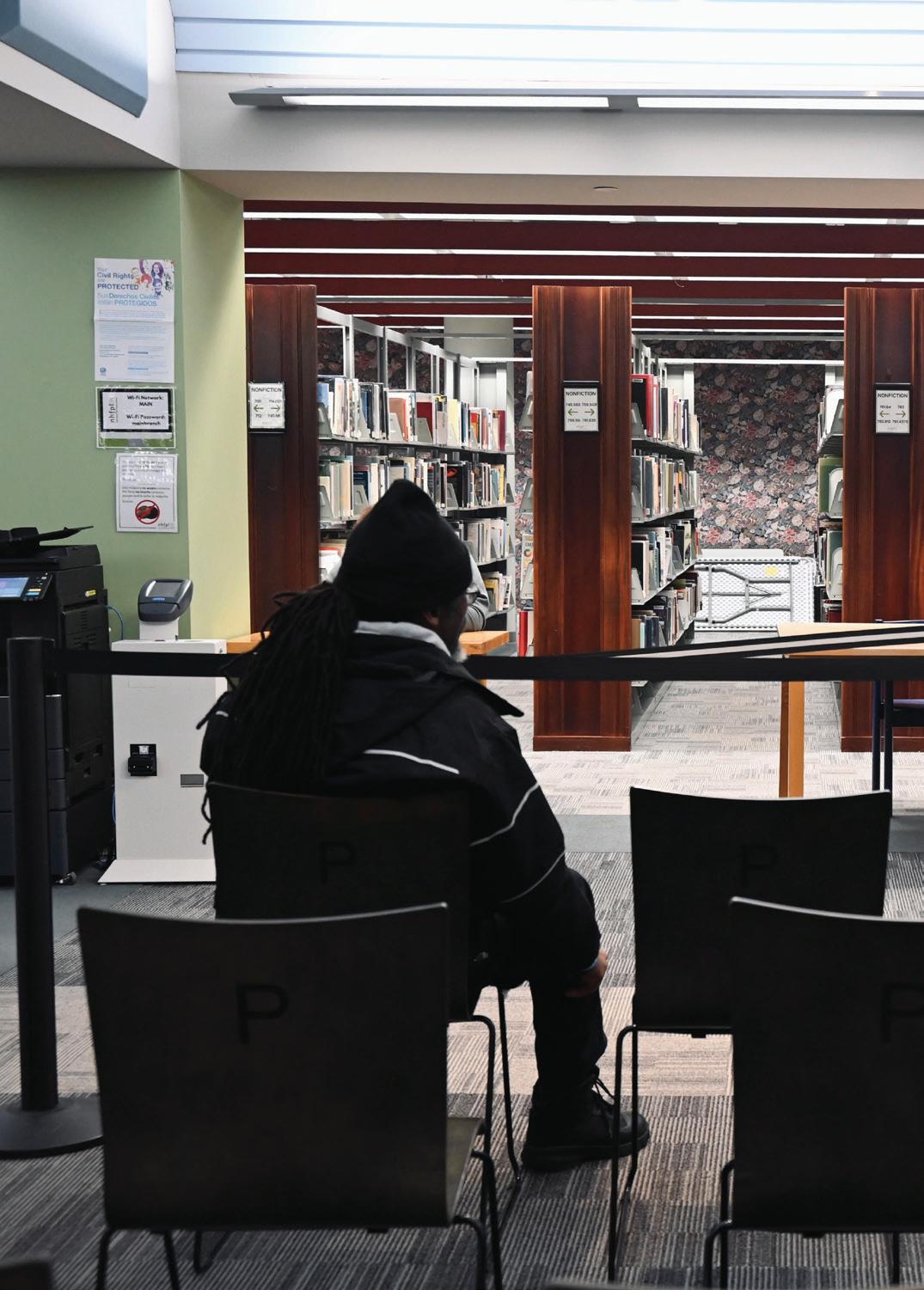
“The city sees this as a very important program,” Costa said, emphasizing the continual support of the New Haven Mayor’s office through events like an annual kickoff. “[B]ecause these funds are coming back in sizable refund amounts to the individuals, to the families, and they spend it in the community, thereby boosting small businesses.”
Although around fifteen VITA sites operate in New Haven, Costa said the downtown NHFPL VITA location is the largest in the state of Connecticut, regularly completing the most returns per year.
The downtown NHFPL site disaffiliated from Yale over the pandemic due
to university restrictions on in-person operations. However, all of NHFPL’s VITA volunteers are Yale students, both undergraduate and graduate. The job demands a high level of responsibility and professionalism from its leadership—other VITA sites often run out of established non-profits, like United Way. Student leaders draw from a deep well of institutional knowledge, working with an extensive list of partnering organizations to make the site function: the NHFPL, Connecticut Association for Human Service, Yale Hunger & Homelessness Action Project, and the IRS
Costa outlined the evolution of the program from its inception in New Haven in the early two-thousands to the present. The site grew steadily in publicity and capacity throughout cycles of Yale student leaders. The COVID-19 pandemic challenged the program, but it has since rebounded, with ninety-eight currently active volunteers. The volunteers I spoke to were motivated to give back
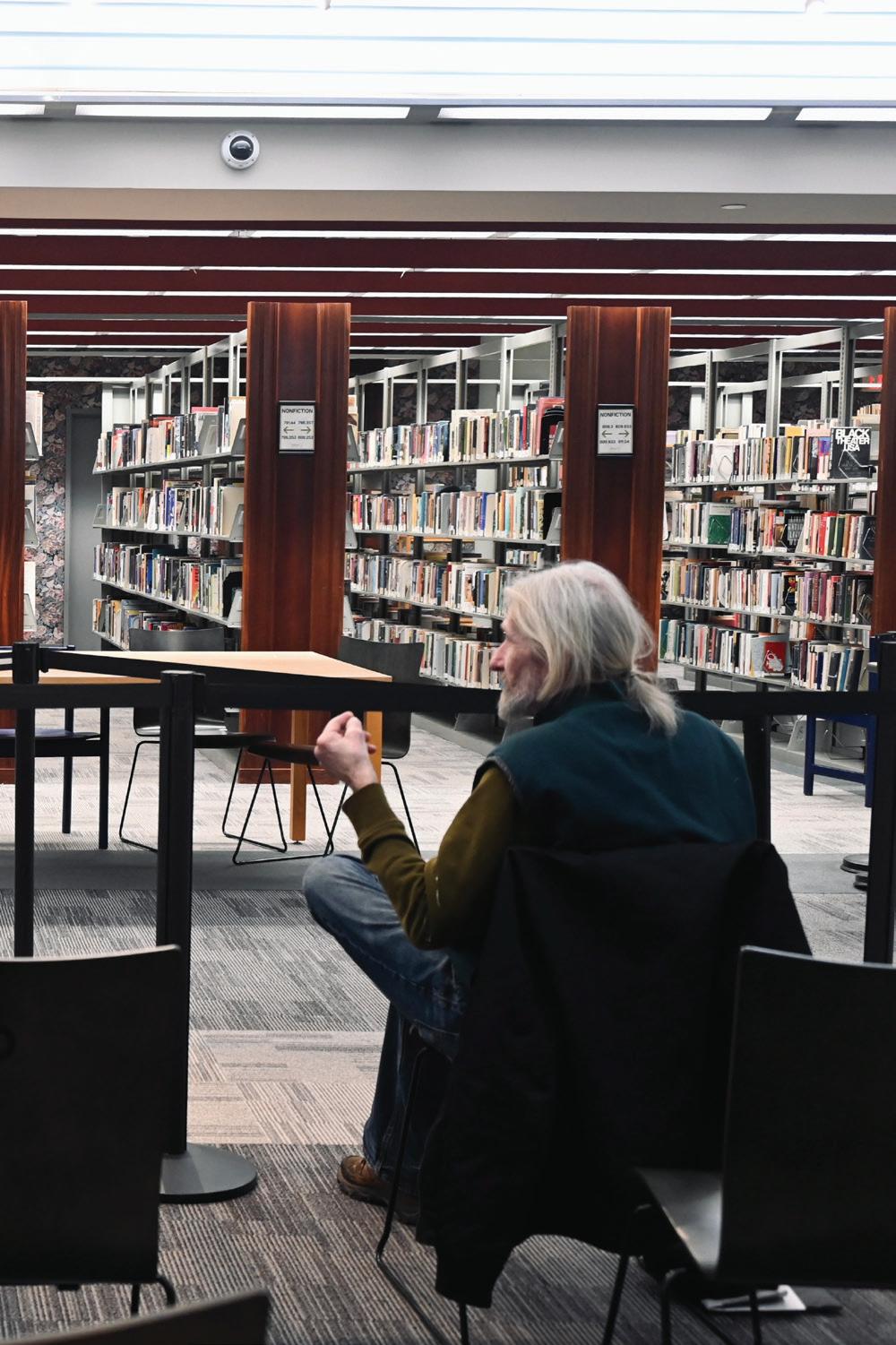
to their communities, choosing VITA because of its ability to make a tangible difference in other’s lives.
“The money that people are getting back makes a huge impact,” Co-President Zhang shared.
VITA sends emails to its volunteers every day the site operates, Monday through Saturday, for about nine weeks until Tax Day on April 15. Each email includes a red number—the amount of money that taxpayers owed that day— and a green number, which is always significantly larger and denotes the amount of money that was returned to clients.
VITA volunteers strive to express sensitivity, respect, and understanding, especially when a client finds out they owe money or that their return is not as sizable as they had expected. Zhang recalled instances when she had to explain to people why their returns were smaller than they expected, especially after pandemic-era expansions of the Child Tax Credit expired. This
thoughtfulness seemed attuned to navigating the vulnerability required of clients and the responsibility given to volunteers on the VITA site.
Every VITA program abides by the IRS prescribed structure. Clients fill out an intake sheet, bringing their Social Security card, an official form of identification, and all relevant tax documents to the site. The VITA volunteer reviews these materials, inputting data into the online tax preparation system “TaxSlayer,” which automatically calculates the return. Before submission, each return is double-checked by a different volunteer. Filing is often simple, as volunteers are limited in scope and unauthorized to prepare for taxpayers with specific, complicated situations. But volunteers still need to know the right questions to ask. For example, if a volunteer misidentifies the filing status of an individual as “single,” instead of “head of household,” the taxpayer may miss out on certain benefits. Volunteers must understand the basics of tax law and be prepared to explain returns to clients.
The Volunteer Standards of Conduct Agreement, signed by all VITA volunteers, reminds volunteers that “fraudulent returns that report incorrect income, credits, or deductions can result in many years of interaction with the IRS as the taxpayer tries to pay the additional tax plus interest and penalties. ”
Over the previous fall semester,
I watched the five training video modules ranging from twenty minutes to an hour that Yale student VITA leaders created, touching on the fundamentals of tax law.
In January, I walked into a lecture hall for VITA’s “Certification Party,” a gathering to pass the IRS’s official certification exams. Although the exam is taken individually online, organizers talked through exam questions in groups, eventually giving each volunteer the correct answers and officially qualifying all participants
to volunteer on an IRS VITA site. The exam guidelines instruct volunteers to take the test individually, noting that “taking the test in groups or with outside assistance is a disservice to the customers you volunteered to help.” However, three out of four of the VITA sites I have interacted with approach the test similarly, in groups with correct answers eventually provided to all volunteers.
Computers out, we gathered in groups according to certification levels, which ranged from “Intake Coordinator” to “Basic Preparer” to “Advanced Preparer.” A veteran VITA volunteer, one of the site coordinators, prompted individuals from my group to read the exam questions aloud while soliciting answers from the group. I strained to hear amongst the echo of the tall, domed ceiling, hushed voices, and the hum of other groups’ discussions. We breezed through the exam. When tougher questions made the group pause, some students opted to switch tabs on their computers to Publication 4012, the official Volunteer Resource Guide. While they searched for official guidance as a volunteer would be expected to do on a VITA site, others sat quietly and waited to be told the correct answer.
When I asked Theo Schiminovich ’25, a new volunteer with VITA, about his level of confidence going into his first session, he paused, choosing his words carefully. “I feel like I’m gonna need to work up to it,” he said. “I’m in the stage right now where I don’t really know what it’s going to look like, so I have this void in my mind.”
Before preparing returns independently, new volunteers shadow experienced ones. Co-President Wypasek described the steps after shadowing as “a gentle push towards doing it on your own.” She added, “we try to also give them the tools so that if they’re stuck, they know what to do next.” Volunteers can search the IRS website or the official Volunteer Resource Guide, ask fellow volunteers questions, and check in with their IRS point of contact. In daily emails, leaders share lessons learned and keep a running document of common questions. As new volunteers build their confidence on the job, capacity is limited early on in the tax season. Wypasek alluded to this bottleneck, warning, “the first week might be very very hectic.”
On the first day of VITA’s operation,
I stood next to Andrea Santiago-Tito SOM ’24. We met in the waiting room; she has used VITA for six years.
“I come here every year because I don’t trust going to other companies and other environments,” Santiago-Tito said. “I feel the Yale students, we have this trust where, they know what they’re doing.”
On the NHFPL flier, the downtown branch is listed plainly among other NHFPL VITA locations and does not advertise its affiliation with Yale students. Sitting among the clients, I noticed how the students seemed like the youngest people on site, with their stickered laptops and backpacks.
Santiago-Tito and I watched the waiting area fill up the middle of the library basement. Earlier, I had witnessed a public argument between a pair of clients who were worried about what order they would be seen in. The library staff and security guards, milling around in reflective layers, diffused the conflict.
“I’m not in a rush to just be first, as long as I get it done,” Santiago-Tito said. I turned my head to the rustling of coats in the waiting area as people stood. Santiago-Tito bolted, securing a space in the rapidly forming line.

One responded, “they take their time, that’s why it takes so long and that’s why people get frustrated and get aggravated, but they gonna make sure they do it right.”
Santiago-Tito was number nineteen among twenty-two taxpayers who were taken that day. VITA volunteers are not allowed to stay after the library closes, so they preemptively limit the number of clients they will see in a day. When I asked Costa, the librarian, about the walk-in format of the site, he explained that a format blended between appointments and walk-ins functioned less efficiently, as appointments were often missed, leaving volunteers with nothing to do. Costa told me that volunteers averaged twenty-eight to thirty-three people every three-and-a-half-hour session.
On the last day of the site’s first week, I returned to the waiting area and sat down next to Clevetta, an older woman bundled in her winter coat, hat, and gloves. She told me that she had attempted to come the day before but had been turned away. This time, one of the library security guards was tasked with handing out numbered index cards to denote those who would make the cut for a session.
“It’s comparable to H&R Block, in my book.” Clevetta remarked. “They’re always thorough, always helpful, always introducing themselves, and very knowledgeable.”
I asked her whether she had faced long wait times before. As we spoke, others
who were waiting began to notice that the index cards had been given out of order, confusing who was to be seen first. Clevetta responded, “No, I’ve been lucky I suppose, or blessed that when I come it’s...” she paused. “This is the first time I’ve seen this many people.” I chalked the chaos up to first week growing pains. Another woman sat down next to us, joining the conversation. In hushed voices, they exchanged stories of the ways companies like H&R Block and Jackson Hewitt had taken their money, tax season after tax season.
Four hours later, I returned from class to the library and was surprised to see familiar faces, including Clevetta, rearranged into different configurations around the room. The Yale students, meanwhile, were transitioning to their third personnel shift of the day. I sat down next to a pair of women talking, playfully analyzing the volunteers’ actions. I asked them about how long they had been waiting. One responded, “they take their time, that’s why it takes so long and that’s why people get frustrated and get aggravated, but they gonna make sure they do it right.” Between those who were waiting, a friendly camaraderie formed. Small conversation and laughter emerged often, disrupting the long stretches of waiting that characterized the site.
I stood to leave again, wishing them good luck. One man tried to get me to stay and wait for my taxes to be complete. “They’ll get them done for you,” he insisted. I smiled, explaining that I was a student, writing a story about the site. “I knew you had that student look about you” he quipped. I chuckled, waving goodbye.
When I returned to the VITA site for a third time during its second week of operation, the waiting chairs were already filled. All twenty-one numbered index cards had been passed out according to arrival time. The site would not be accepting anyone new that day. As the clients stood, I watched them arrange themselves into a neat line between the stanchions. I wondered if it was like this all tax season: demand high, the atmosphere thick with waiting, and the site at full capacity. ∎
Ai-Li Hollander is a first-year in Morse College.
The first time i go to the Yale Farm, I am reminded of Marie Antoinette and Le Hameau de la Reine, the ornamental village she built outside Versailles. She would put on her best peasant dress and wander between the dovecote and the dairy, where it is said (alas, apocryphally) that she enjoyed milking goats adorned with ribbons. This is not an exact analogy for the farm, but it’s pretty close, I think, locking my bike to a lamppost. Yale students, too, sometimes stray from their castles to spend an afternoon picking vegetables they did not plant.
The farm is about a mile from the center of Yale’s campus, past the mansions on Hillhouse Avenue and the old laboratories on Prospect Street. It occupies almost an acre of university grounds, tightly planted with rows of vegetables and herbs. The farm has no buildings, just a wooden pavilion that protects its red-brick pizza oven and picnic tables from the elements.
Property Manager Jeremy Oldfield waves from his riding mower as I cut uphill toward the middle of the farm. I wave back and wait for him under the pavilion. We’re several days into a scorching September heatwave, but it’s not yet 10 a.m. and the farm is still cool and dewy. The last of the late summer light pours out onto the apple trees, the rows of squash and corn, the ragged bed of wildflowers that separates the farm from the street. Up here, if the sky is right, you can see all the way to the Long Island Sound.
“This is an interesting hillside we’re sitting on,” Jeremy says. Before it was a farm, the land belonged to William Whitman Farnam, a member of the Yale Corporation who lived at the top of the hill. When Farnam died in 1929, his widow promised their estate to Yale on the condition that the university wouldn’t build on the land, devoting it instead to the study of plants. The hillside was largely ignored until 2000, when a band of students called “Food from the Earth” began lobbying to turn it into a farm. Their cause was taken up by Alice Waters—a Yale parent and the grand dame of California’s farm-to-table scene—who talked then-university president Richard Levin into the idea. Students broke ground on the farm in the spring of 2003, nicknaming it the Old Acre.
“The myth was that the students came under the cover of darkness with chainsaws,” Jeremy tells me. “Everything needs a nice, dramatic creation myth.” Jeremy is 41, with sandy hair and a big laugh. He spent years farming in Maine and California, but the Yale Farm is unlike any he’s worked at before. Most of its crops are selected not for their ability to feed a family or turn a profit, but because they’re “narratively interesting,” he says. Last year, Jeremy and his student employees planted a field illustrating several centuries of grain evolution; this year, they’re growing indigo for an art class studying the history of dye production.
It’s the farm’s capacity for storytelling that interests student manager Calista Washburn ’24. I meet her on a golden evening after one of the farm’s weekly open workdays. We sit in the grass under an apple tree, watching fat white hens peck inside a coop a few yards away. When a group of sophomores comes over to ask if they’re allowed to pick the apples, she gently tells them that no, the farm is saving them for a Russian literature class reading a play with an extended fruit-picking metaphor, but they’re welcome to any that have already fallen.
“There’s hilarious impracticalities here,” Calista says, laughing as she tells me about how much time students on the farm spend hand-weeding the vegetables and about the week they used tiny scythes to harvest wheat. “It totally changed the way I understood history and technology and feeding people.”
Here, she explains, there are no boundaries between the dirt of the real world and the ideas taught down the hill. There are also no physical boundaries between the farm and the rest of Yale, no locked gates or requirements for entry. This is why Calista has recently become so concerned about the deer, who have been grazing on the farm’s sweet potato plants in droves since the beginning of the summer. A commercial farm might shoot the deer or scare them off with deafening sound alarms, but neither of these are feasible options on a college campus. The Yale Farm has discussed

keeping the deer out with an 8-foot fence, the kind of barrier that it has intentionally resisted for its twenty years of existence. Jeremy tells me a fence could go up as early as this spring, but there is still no definite plan in place.
The two other student farm managers I speak to both independently bring up the dilemma with the deer. “It’s this crisis moment,” one of them, Natalie Smink ’24, tells me emphatically. But when I talk to Jeremy about it, he doesn’t seem too concerned. The students will
find a way to protect the sweet potatoes, and if that means building a fence around the farm, then they’ll find new ways of inviting people in. This is one of the farm’s true purposes, he tells me: to provide students who are used to studying ideas in the abstract with tangible problems to solve.
“You’ll go through a bed of carrots that is wild and wooly with three different types of weeds, and by the end of the workday it is legibly a carrot bed,” Jeremy says. “You find students kind of lingering
there, in front of this living physical testament of the work that they just did.”
And even after only a few hours on the farm, I believe him. Because perhaps this is what all of us, even Marie Antoinette, are doing: searching in the dirt for something that feels alive and real and good. ∎
1 Men's underwear, for short
5 Lariat
10 Knocks
14 The right to possession of a property belonging to someone else, until their debt is discharged.
15
16
17
29
various caesium clocks
37 Hide
38 Seventeenth-century Dutch Huguenot from sourthern Africa
39 *Element of this puzzle’s theme where one might “Nose Grab”*
42 Without fault
45 Sap-feeding bug found on conifers
46 Haggard
47 Humble
48 *Element of this puzzle’s theme where one might “Grind”*
51 Fine, in Scotland
52 Enterprise
54 Incan sun-god
55 New recruit, maybe
56 Enthusiasm
57 Sugary finales?
58 Tableau
59 Specialized coding languages like HTML
1 Used thrice, a replacement fo rother words that would communicate little


© The New Journal
2 Benefice
3 Went downhill
4 Extinguished
5 Fairly delayed
6 Above
7 “Ditto”
8 Autoimmune disease in whcih the immune system attacks it own tissue, abbr.
9 Pabst's “Chicago’s Beer”
10 Rapid succession of knocking sounds.
11 Elizabethan call-to-arms
12 First Emperor of Russia
13 Preliminarily ranked
18 Sunscreen data
22 Christmastime hymn
24 Halves
25 Unit of meas. for milk
26 Humiliated
30 Suffix signifying relation or composition
32 Tokens
33 “War without bloodshed,” per Mao Zedong
34 They might become ingrown, if cut too short
35 Summertime
36 Org. responsible for VITA
37 The Chronicles of Narnia author
38 Revealed
March 2024
39 Change: Sp.
40 Decorates
41 Having the characteristics of a foot
43 Inflame
44 Zilch
48 Conceal
49 Ancient Egypt’s divine disc
50 A way to see something
53 Drug administered for paracetamol overdose and to loosen thick mucus, included on the WHO's list of essential medicines.

